Developing Professional Practice in Learning and Development
VerifiedAdded on 2023/06/03
|27
|6272
|399
AI Summary
This article discusses the importance of cognitive learning and practical application of skills for professional development. It covers topics such as current practices, roles, and trends in learning and development, self-assessment and time management, teamwork, and the impact of political behavior on organizational learning and development. The article also provides techniques for analyzing and resolving problems and CPD techniques for implementing and revising personal development plans.
Contribute Materials
Your contribution can guide someone’s learning journey. Share your
documents today.
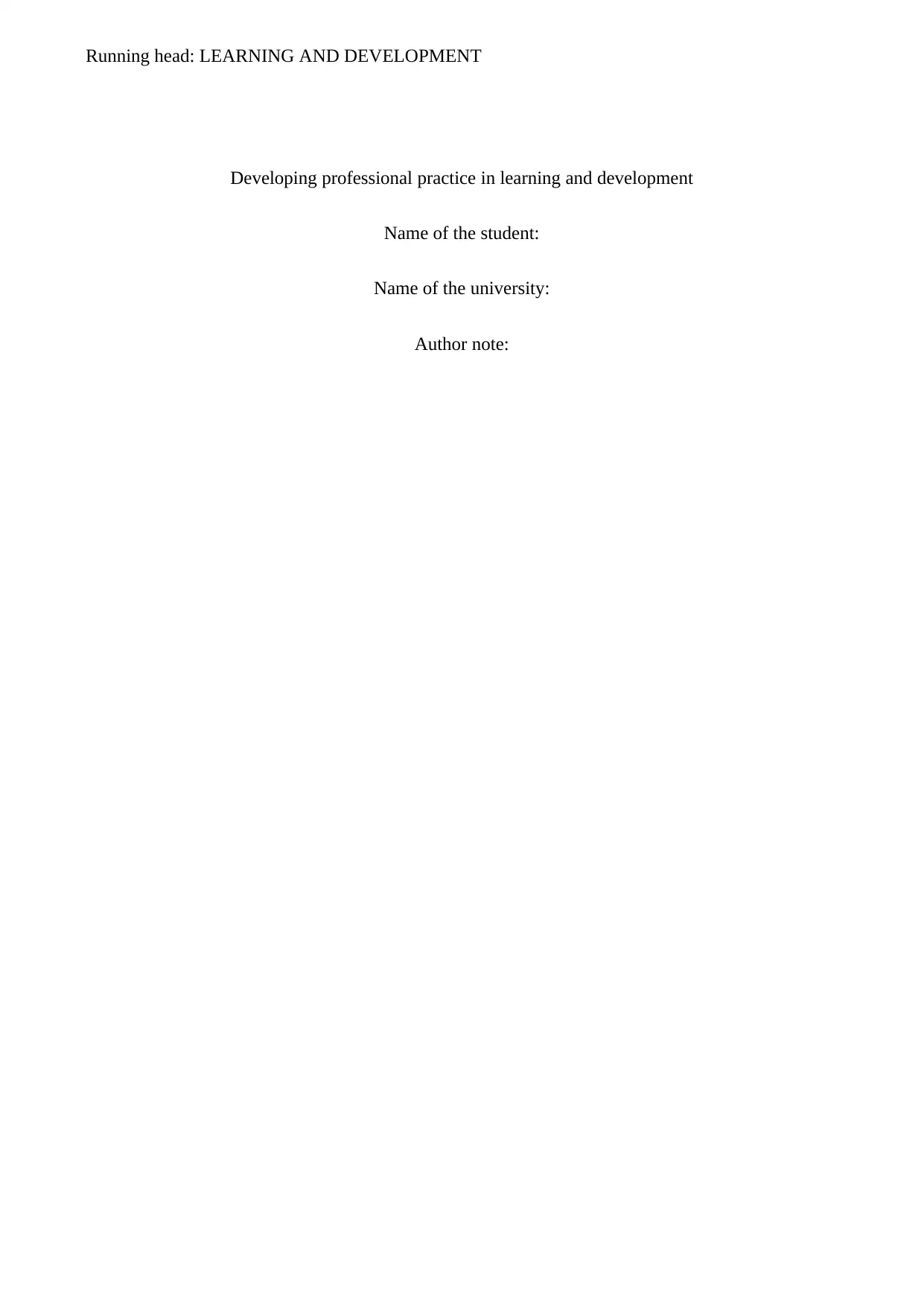
Running head: LEARNING AND DEVELOPMENT
Developing professional practice in learning and development
Name of the student:
Name of the university:
Author note:
Developing professional practice in learning and development
Name of the student:
Name of the university:
Author note:
Secure Best Marks with AI Grader
Need help grading? Try our AI Grader for instant feedback on your assignments.
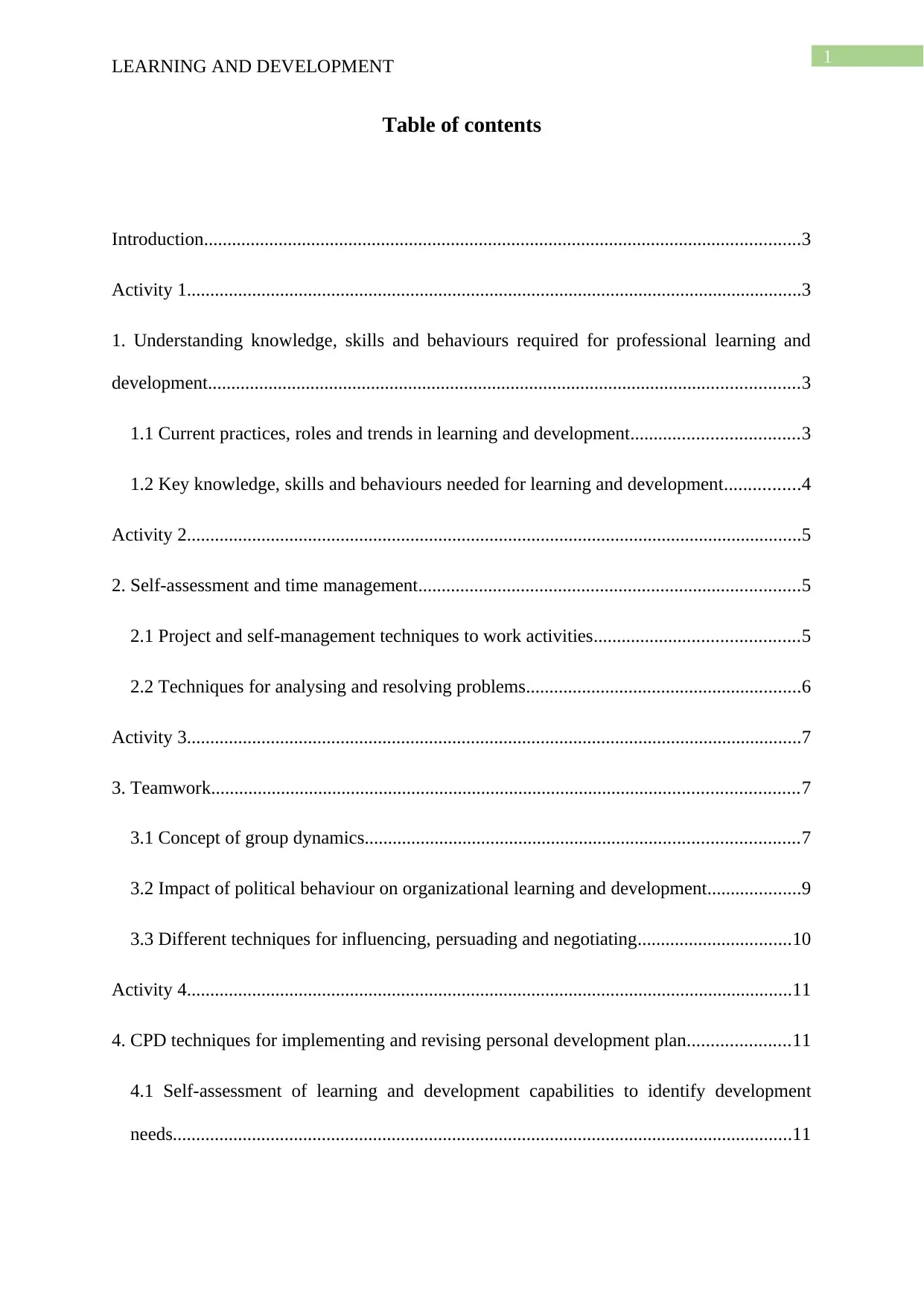
1
LEARNING AND DEVELOPMENT
Table of contents
Introduction................................................................................................................................3
Activity 1....................................................................................................................................3
1. Understanding knowledge, skills and behaviours required for professional learning and
development...............................................................................................................................3
1.1 Current practices, roles and trends in learning and development....................................3
1.2 Key knowledge, skills and behaviours needed for learning and development................4
Activity 2....................................................................................................................................5
2. Self-assessment and time management..................................................................................5
2.1 Project and self-management techniques to work activities............................................5
2.2 Techniques for analysing and resolving problems...........................................................6
Activity 3....................................................................................................................................7
3. Teamwork..............................................................................................................................7
3.1 Concept of group dynamics.............................................................................................7
3.2 Impact of political behaviour on organizational learning and development....................9
3.3 Different techniques for influencing, persuading and negotiating.................................10
Activity 4..................................................................................................................................11
4. CPD techniques for implementing and revising personal development plan......................11
4.1 Self-assessment of learning and development capabilities to identify development
needs.....................................................................................................................................11
LEARNING AND DEVELOPMENT
Table of contents
Introduction................................................................................................................................3
Activity 1....................................................................................................................................3
1. Understanding knowledge, skills and behaviours required for professional learning and
development...............................................................................................................................3
1.1 Current practices, roles and trends in learning and development....................................3
1.2 Key knowledge, skills and behaviours needed for learning and development................4
Activity 2....................................................................................................................................5
2. Self-assessment and time management..................................................................................5
2.1 Project and self-management techniques to work activities............................................5
2.2 Techniques for analysing and resolving problems...........................................................6
Activity 3....................................................................................................................................7
3. Teamwork..............................................................................................................................7
3.1 Concept of group dynamics.............................................................................................7
3.2 Impact of political behaviour on organizational learning and development....................9
3.3 Different techniques for influencing, persuading and negotiating.................................10
Activity 4..................................................................................................................................11
4. CPD techniques for implementing and revising personal development plan......................11
4.1 Self-assessment of learning and development capabilities to identify development
needs.....................................................................................................................................11
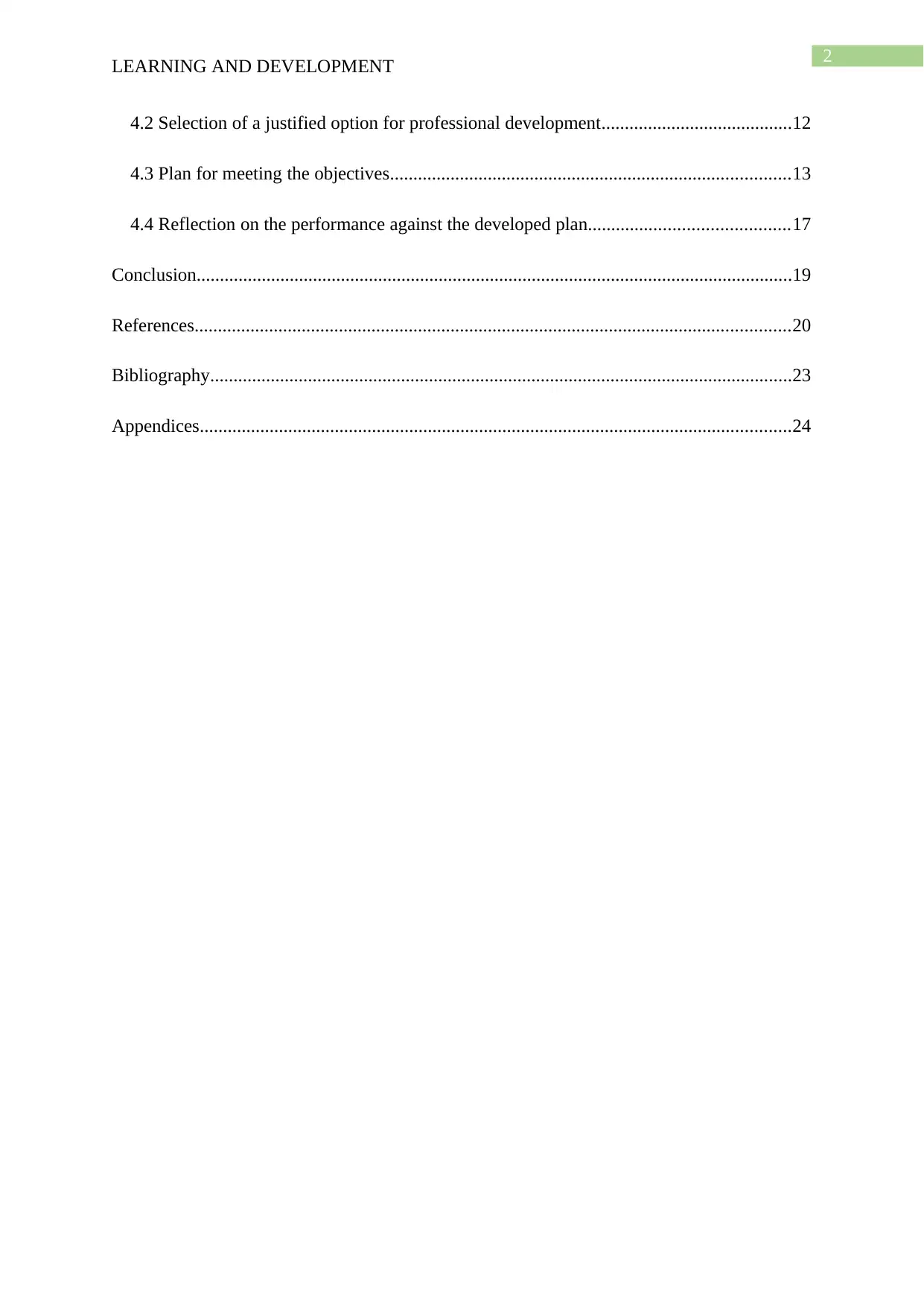
2
LEARNING AND DEVELOPMENT
4.2 Selection of a justified option for professional development.........................................12
4.3 Plan for meeting the objectives......................................................................................13
4.4 Reflection on the performance against the developed plan...........................................17
Conclusion................................................................................................................................19
References................................................................................................................................20
Bibliography.............................................................................................................................23
Appendices...............................................................................................................................24
LEARNING AND DEVELOPMENT
4.2 Selection of a justified option for professional development.........................................12
4.3 Plan for meeting the objectives......................................................................................13
4.4 Reflection on the performance against the developed plan...........................................17
Conclusion................................................................................................................................19
References................................................................................................................................20
Bibliography.............................................................................................................................23
Appendices...............................................................................................................................24
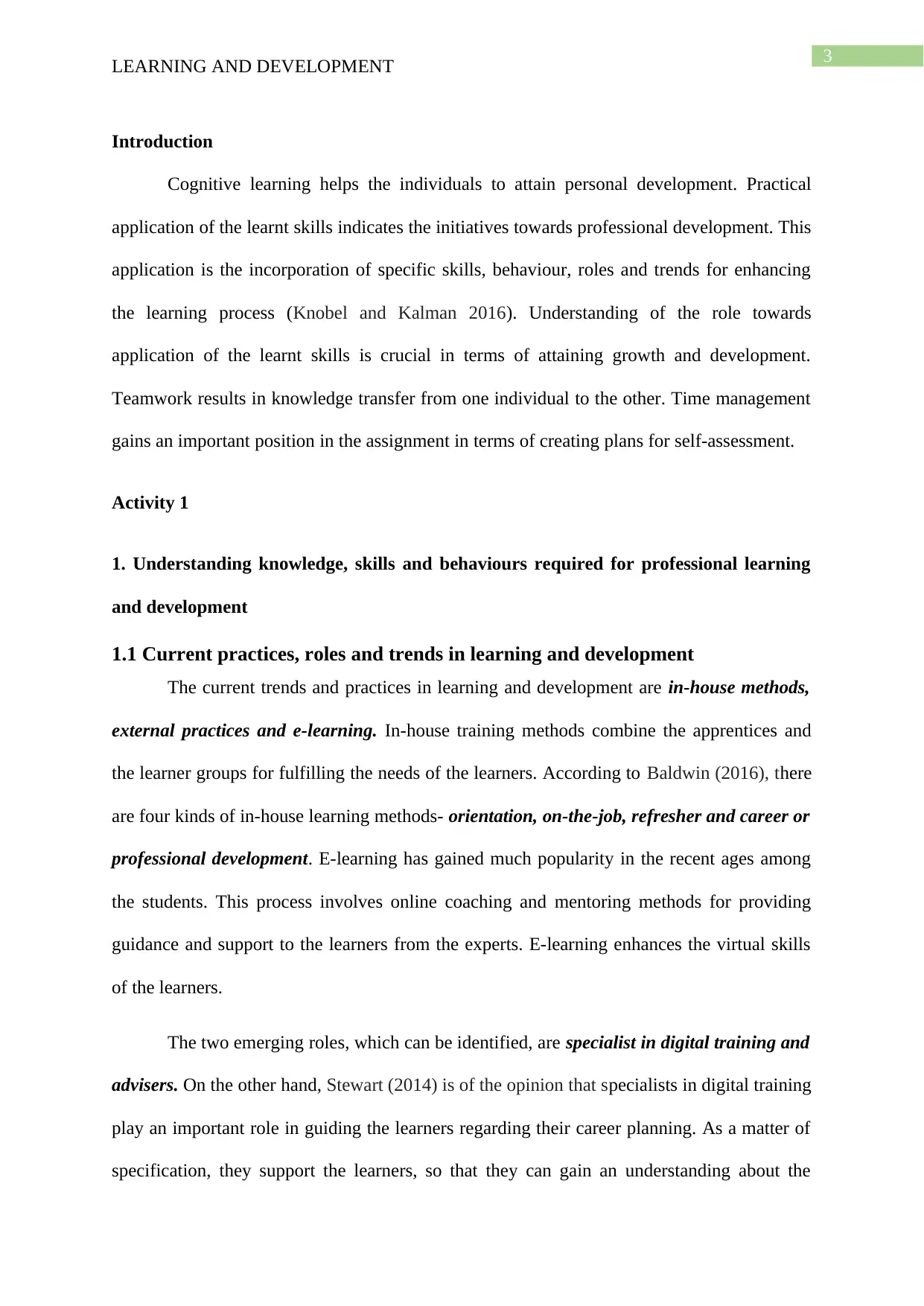
3
LEARNING AND DEVELOPMENT
Introduction
Cognitive learning helps the individuals to attain personal development. Practical
application of the learnt skills indicates the initiatives towards professional development. This
application is the incorporation of specific skills, behaviour, roles and trends for enhancing
the learning process (Knobel and Kalman 2016). Understanding of the role towards
application of the learnt skills is crucial in terms of attaining growth and development.
Teamwork results in knowledge transfer from one individual to the other. Time management
gains an important position in the assignment in terms of creating plans for self-assessment.
Activity 1
1. Understanding knowledge, skills and behaviours required for professional learning
and development
1.1 Current practices, roles and trends in learning and development
The current trends and practices in learning and development are in-house methods,
external practices and e-learning. In-house training methods combine the apprentices and
the learner groups for fulfilling the needs of the learners. According to Baldwin (2016), there
are four kinds of in-house learning methods- orientation, on-the-job, refresher and career or
professional development. E-learning has gained much popularity in the recent ages among
the students. This process involves online coaching and mentoring methods for providing
guidance and support to the learners from the experts. E-learning enhances the virtual skills
of the learners.
The two emerging roles, which can be identified, are specialist in digital training and
advisers. On the other hand, Stewart (2014) is of the opinion that specialists in digital training
play an important role in guiding the learners regarding their career planning. As a matter of
specification, they support the learners, so that they can gain an understanding about the
LEARNING AND DEVELOPMENT
Introduction
Cognitive learning helps the individuals to attain personal development. Practical
application of the learnt skills indicates the initiatives towards professional development. This
application is the incorporation of specific skills, behaviour, roles and trends for enhancing
the learning process (Knobel and Kalman 2016). Understanding of the role towards
application of the learnt skills is crucial in terms of attaining growth and development.
Teamwork results in knowledge transfer from one individual to the other. Time management
gains an important position in the assignment in terms of creating plans for self-assessment.
Activity 1
1. Understanding knowledge, skills and behaviours required for professional learning
and development
1.1 Current practices, roles and trends in learning and development
The current trends and practices in learning and development are in-house methods,
external practices and e-learning. In-house training methods combine the apprentices and
the learner groups for fulfilling the needs of the learners. According to Baldwin (2016), there
are four kinds of in-house learning methods- orientation, on-the-job, refresher and career or
professional development. E-learning has gained much popularity in the recent ages among
the students. This process involves online coaching and mentoring methods for providing
guidance and support to the learners from the experts. E-learning enhances the virtual skills
of the learners.
The two emerging roles, which can be identified, are specialist in digital training and
advisers. On the other hand, Stewart (2014) is of the opinion that specialists in digital training
play an important role in guiding the learners regarding their career planning. As a matter of
specification, they support the learners, so that they can gain an understanding about the
Secure Best Marks with AI Grader
Need help grading? Try our AI Grader for instant feedback on your assignments.
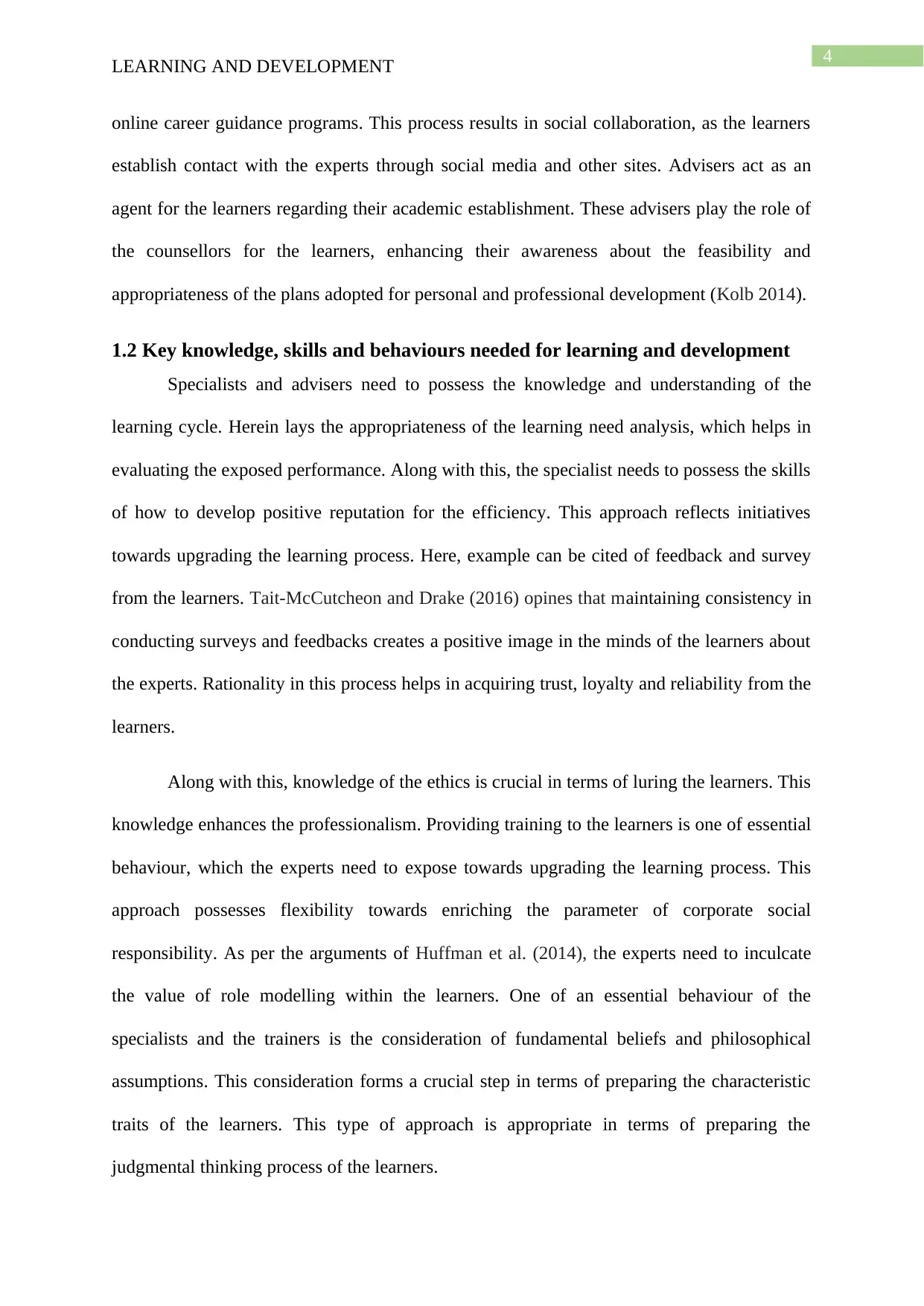
4
LEARNING AND DEVELOPMENT
online career guidance programs. This process results in social collaboration, as the learners
establish contact with the experts through social media and other sites. Advisers act as an
agent for the learners regarding their academic establishment. These advisers play the role of
the counsellors for the learners, enhancing their awareness about the feasibility and
appropriateness of the plans adopted for personal and professional development (Kolb 2014).
1.2 Key knowledge, skills and behaviours needed for learning and development
Specialists and advisers need to possess the knowledge and understanding of the
learning cycle. Herein lays the appropriateness of the learning need analysis, which helps in
evaluating the exposed performance. Along with this, the specialist needs to possess the skills
of how to develop positive reputation for the efficiency. This approach reflects initiatives
towards upgrading the learning process. Here, example can be cited of feedback and survey
from the learners. Tait-McCutcheon and Drake (2016) opines that maintaining consistency in
conducting surveys and feedbacks creates a positive image in the minds of the learners about
the experts. Rationality in this process helps in acquiring trust, loyalty and reliability from the
learners.
Along with this, knowledge of the ethics is crucial in terms of luring the learners. This
knowledge enhances the professionalism. Providing training to the learners is one of essential
behaviour, which the experts need to expose towards upgrading the learning process. This
approach possesses flexibility towards enriching the parameter of corporate social
responsibility. As per the arguments of Huffman et al. (2014), the experts need to inculcate
the value of role modelling within the learners. One of an essential behaviour of the
specialists and the trainers is the consideration of fundamental beliefs and philosophical
assumptions. This consideration forms a crucial step in terms of preparing the characteristic
traits of the learners. This type of approach is appropriate in terms of preparing the
judgmental thinking process of the learners.
LEARNING AND DEVELOPMENT
online career guidance programs. This process results in social collaboration, as the learners
establish contact with the experts through social media and other sites. Advisers act as an
agent for the learners regarding their academic establishment. These advisers play the role of
the counsellors for the learners, enhancing their awareness about the feasibility and
appropriateness of the plans adopted for personal and professional development (Kolb 2014).
1.2 Key knowledge, skills and behaviours needed for learning and development
Specialists and advisers need to possess the knowledge and understanding of the
learning cycle. Herein lays the appropriateness of the learning need analysis, which helps in
evaluating the exposed performance. Along with this, the specialist needs to possess the skills
of how to develop positive reputation for the efficiency. This approach reflects initiatives
towards upgrading the learning process. Here, example can be cited of feedback and survey
from the learners. Tait-McCutcheon and Drake (2016) opines that maintaining consistency in
conducting surveys and feedbacks creates a positive image in the minds of the learners about
the experts. Rationality in this process helps in acquiring trust, loyalty and reliability from the
learners.
Along with this, knowledge of the ethics is crucial in terms of luring the learners. This
knowledge enhances the professionalism. Providing training to the learners is one of essential
behaviour, which the experts need to expose towards upgrading the learning process. This
approach possesses flexibility towards enriching the parameter of corporate social
responsibility. As per the arguments of Huffman et al. (2014), the experts need to inculcate
the value of role modelling within the learners. One of an essential behaviour of the
specialists and the trainers is the consideration of fundamental beliefs and philosophical
assumptions. This consideration forms a crucial step in terms of preparing the characteristic
traits of the learners. This type of approach is appropriate in terms of preparing the
judgmental thinking process of the learners.
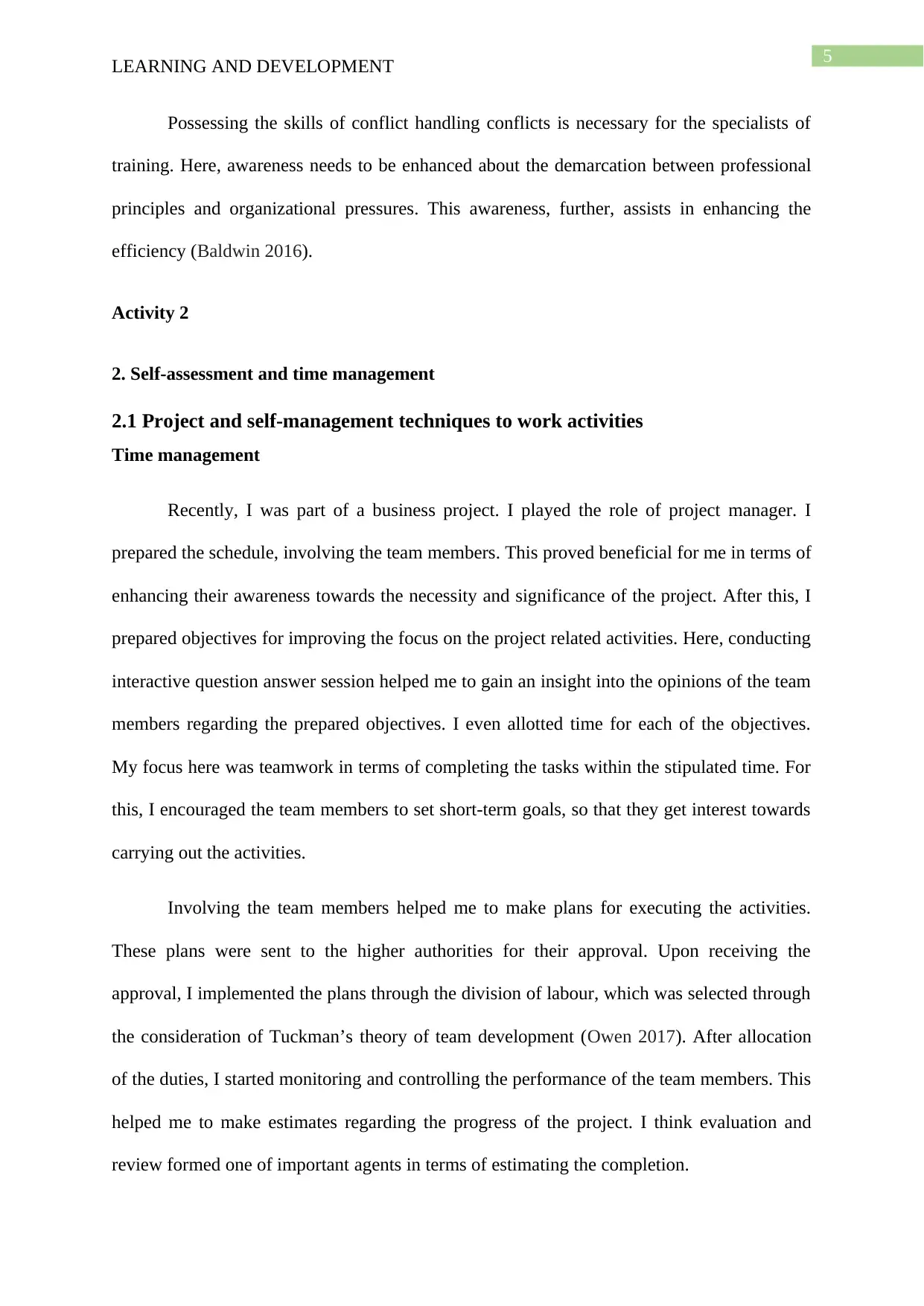
5
LEARNING AND DEVELOPMENT
Possessing the skills of conflict handling conflicts is necessary for the specialists of
training. Here, awareness needs to be enhanced about the demarcation between professional
principles and organizational pressures. This awareness, further, assists in enhancing the
efficiency (Baldwin 2016).
Activity 2
2. Self-assessment and time management
2.1 Project and self-management techniques to work activities
Time management
Recently, I was part of a business project. I played the role of project manager. I
prepared the schedule, involving the team members. This proved beneficial for me in terms of
enhancing their awareness towards the necessity and significance of the project. After this, I
prepared objectives for improving the focus on the project related activities. Here, conducting
interactive question answer session helped me to gain an insight into the opinions of the team
members regarding the prepared objectives. I even allotted time for each of the objectives.
My focus here was teamwork in terms of completing the tasks within the stipulated time. For
this, I encouraged the team members to set short-term goals, so that they get interest towards
carrying out the activities.
Involving the team members helped me to make plans for executing the activities.
These plans were sent to the higher authorities for their approval. Upon receiving the
approval, I implemented the plans through the division of labour, which was selected through
the consideration of Tuckman’s theory of team development (Owen 2017). After allocation
of the duties, I started monitoring and controlling the performance of the team members. This
helped me to make estimates regarding the progress of the project. I think evaluation and
review formed one of important agents in terms of estimating the completion.
LEARNING AND DEVELOPMENT
Possessing the skills of conflict handling conflicts is necessary for the specialists of
training. Here, awareness needs to be enhanced about the demarcation between professional
principles and organizational pressures. This awareness, further, assists in enhancing the
efficiency (Baldwin 2016).
Activity 2
2. Self-assessment and time management
2.1 Project and self-management techniques to work activities
Time management
Recently, I was part of a business project. I played the role of project manager. I
prepared the schedule, involving the team members. This proved beneficial for me in terms of
enhancing their awareness towards the necessity and significance of the project. After this, I
prepared objectives for improving the focus on the project related activities. Here, conducting
interactive question answer session helped me to gain an insight into the opinions of the team
members regarding the prepared objectives. I even allotted time for each of the objectives.
My focus here was teamwork in terms of completing the tasks within the stipulated time. For
this, I encouraged the team members to set short-term goals, so that they get interest towards
carrying out the activities.
Involving the team members helped me to make plans for executing the activities.
These plans were sent to the higher authorities for their approval. Upon receiving the
approval, I implemented the plans through the division of labour, which was selected through
the consideration of Tuckman’s theory of team development (Owen 2017). After allocation
of the duties, I started monitoring and controlling the performance of the team members. This
helped me to make estimates regarding the progress of the project. I think evaluation and
review formed one of important agents in terms of estimating the completion.
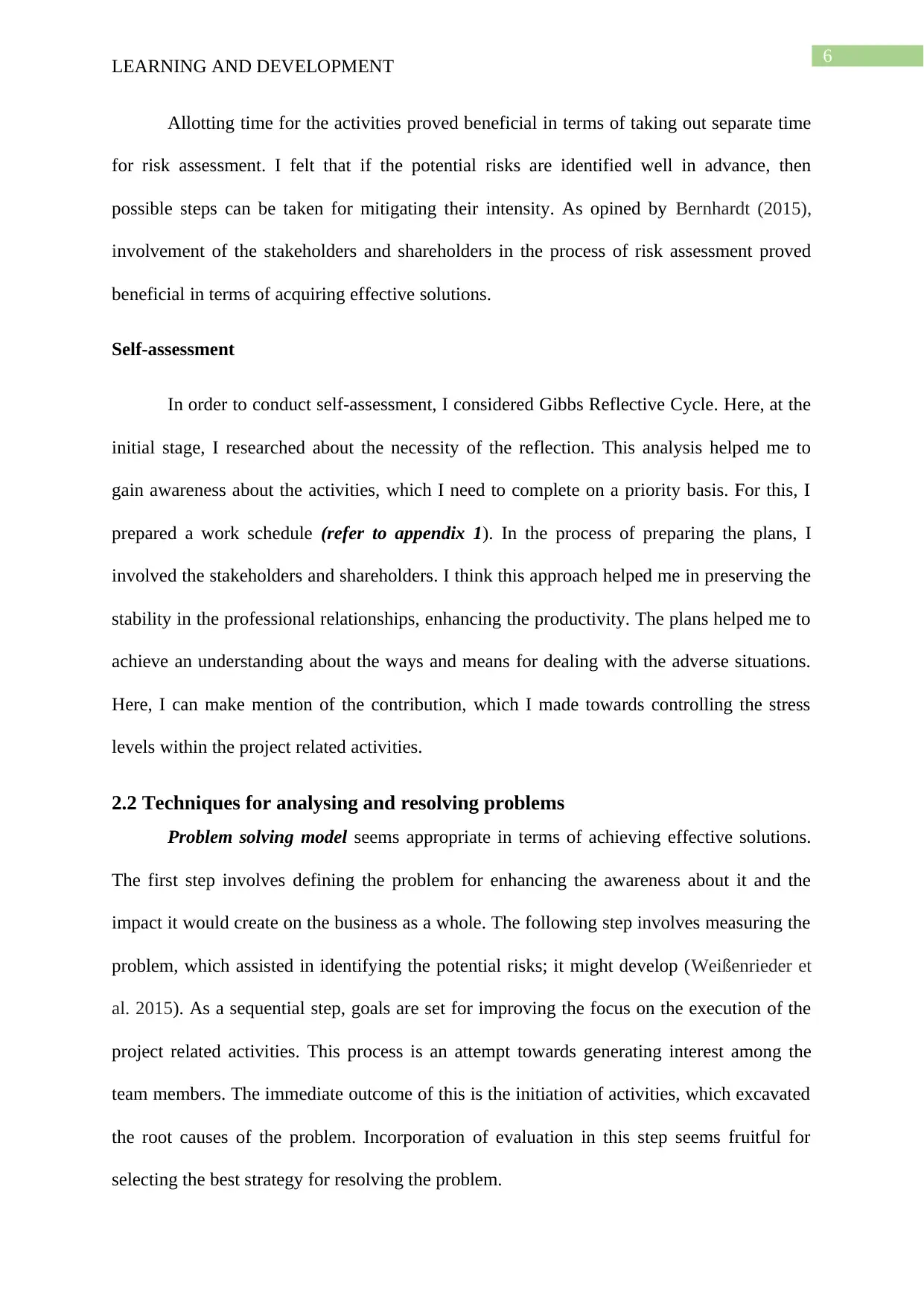
6
LEARNING AND DEVELOPMENT
Allotting time for the activities proved beneficial in terms of taking out separate time
for risk assessment. I felt that if the potential risks are identified well in advance, then
possible steps can be taken for mitigating their intensity. As opined by Bernhardt (2015),
involvement of the stakeholders and shareholders in the process of risk assessment proved
beneficial in terms of acquiring effective solutions.
Self-assessment
In order to conduct self-assessment, I considered Gibbs Reflective Cycle. Here, at the
initial stage, I researched about the necessity of the reflection. This analysis helped me to
gain awareness about the activities, which I need to complete on a priority basis. For this, I
prepared a work schedule (refer to appendix 1). In the process of preparing the plans, I
involved the stakeholders and shareholders. I think this approach helped me in preserving the
stability in the professional relationships, enhancing the productivity. The plans helped me to
achieve an understanding about the ways and means for dealing with the adverse situations.
Here, I can make mention of the contribution, which I made towards controlling the stress
levels within the project related activities.
2.2 Techniques for analysing and resolving problems
Problem solving model seems appropriate in terms of achieving effective solutions.
The first step involves defining the problem for enhancing the awareness about it and the
impact it would create on the business as a whole. The following step involves measuring the
problem, which assisted in identifying the potential risks; it might develop (Weißenrieder et
al. 2015). As a sequential step, goals are set for improving the focus on the execution of the
project related activities. This process is an attempt towards generating interest among the
team members. The immediate outcome of this is the initiation of activities, which excavated
the root causes of the problem. Incorporation of evaluation in this step seems fruitful for
selecting the best strategy for resolving the problem.
LEARNING AND DEVELOPMENT
Allotting time for the activities proved beneficial in terms of taking out separate time
for risk assessment. I felt that if the potential risks are identified well in advance, then
possible steps can be taken for mitigating their intensity. As opined by Bernhardt (2015),
involvement of the stakeholders and shareholders in the process of risk assessment proved
beneficial in terms of acquiring effective solutions.
Self-assessment
In order to conduct self-assessment, I considered Gibbs Reflective Cycle. Here, at the
initial stage, I researched about the necessity of the reflection. This analysis helped me to
gain awareness about the activities, which I need to complete on a priority basis. For this, I
prepared a work schedule (refer to appendix 1). In the process of preparing the plans, I
involved the stakeholders and shareholders. I think this approach helped me in preserving the
stability in the professional relationships, enhancing the productivity. The plans helped me to
achieve an understanding about the ways and means for dealing with the adverse situations.
Here, I can make mention of the contribution, which I made towards controlling the stress
levels within the project related activities.
2.2 Techniques for analysing and resolving problems
Problem solving model seems appropriate in terms of achieving effective solutions.
The first step involves defining the problem for enhancing the awareness about it and the
impact it would create on the business as a whole. The following step involves measuring the
problem, which assisted in identifying the potential risks; it might develop (Weißenrieder et
al. 2015). As a sequential step, goals are set for improving the focus on the execution of the
project related activities. This process is an attempt towards generating interest among the
team members. The immediate outcome of this is the initiation of activities, which excavated
the root causes of the problem. Incorporation of evaluation in this step seems fruitful for
selecting the best strategy for resolving the problem.
Paraphrase This Document
Need a fresh take? Get an instant paraphrase of this document with our AI Paraphraser
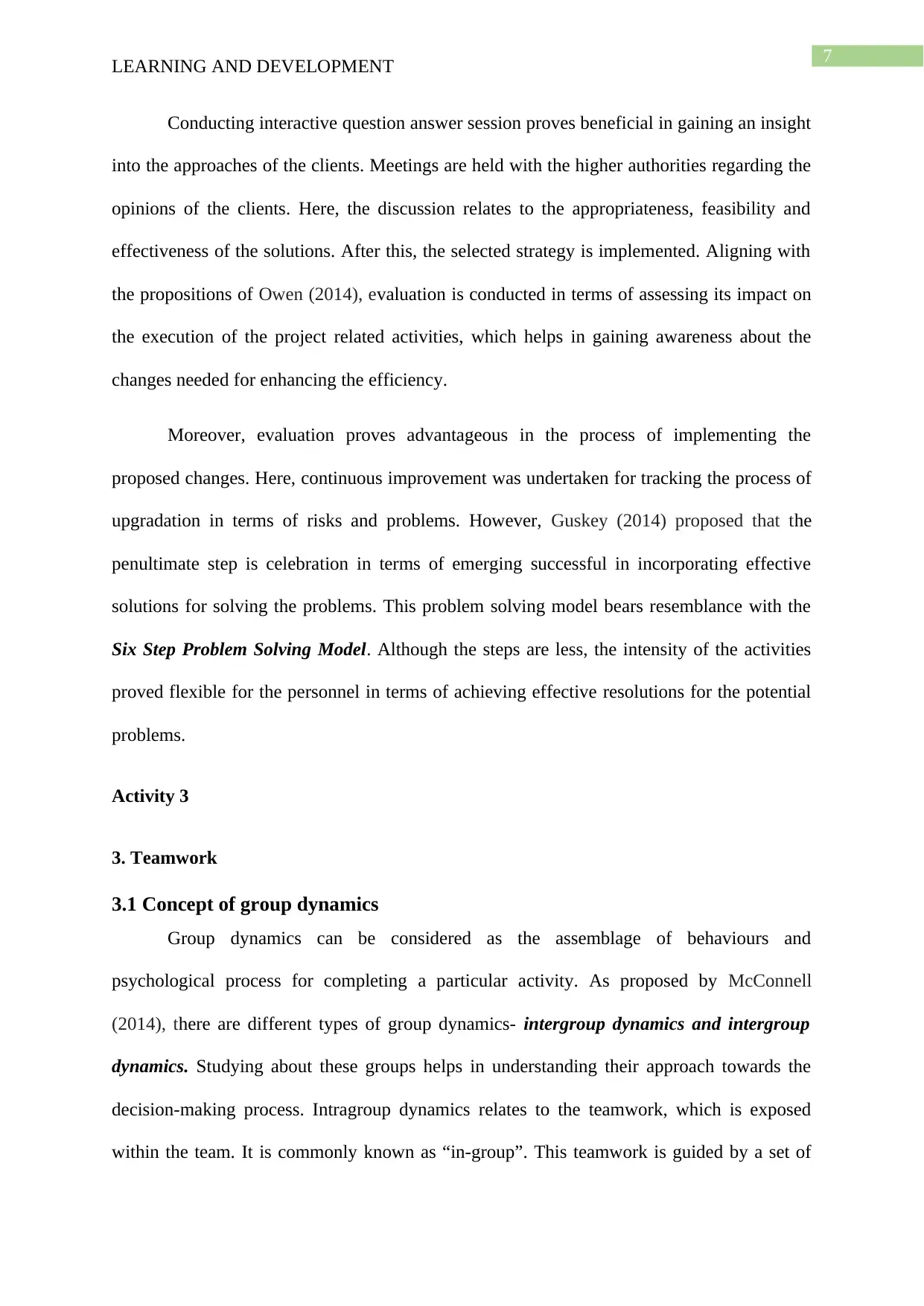
7
LEARNING AND DEVELOPMENT
Conducting interactive question answer session proves beneficial in gaining an insight
into the approaches of the clients. Meetings are held with the higher authorities regarding the
opinions of the clients. Here, the discussion relates to the appropriateness, feasibility and
effectiveness of the solutions. After this, the selected strategy is implemented. Aligning with
the propositions of Owen (2014), evaluation is conducted in terms of assessing its impact on
the execution of the project related activities, which helps in gaining awareness about the
changes needed for enhancing the efficiency.
Moreover, evaluation proves advantageous in the process of implementing the
proposed changes. Here, continuous improvement was undertaken for tracking the process of
upgradation in terms of risks and problems. However, Guskey (2014) proposed that the
penultimate step is celebration in terms of emerging successful in incorporating effective
solutions for solving the problems. This problem solving model bears resemblance with the
Six Step Problem Solving Model. Although the steps are less, the intensity of the activities
proved flexible for the personnel in terms of achieving effective resolutions for the potential
problems.
Activity 3
3. Teamwork
3.1 Concept of group dynamics
Group dynamics can be considered as the assemblage of behaviours and
psychological process for completing a particular activity. As proposed by McConnell
(2014), there are different types of group dynamics- intergroup dynamics and intergroup
dynamics. Studying about these groups helps in understanding their approach towards the
decision-making process. Intragroup dynamics relates to the teamwork, which is exposed
within the team. It is commonly known as “in-group”. This teamwork is guided by a set of
LEARNING AND DEVELOPMENT
Conducting interactive question answer session proves beneficial in gaining an insight
into the approaches of the clients. Meetings are held with the higher authorities regarding the
opinions of the clients. Here, the discussion relates to the appropriateness, feasibility and
effectiveness of the solutions. After this, the selected strategy is implemented. Aligning with
the propositions of Owen (2014), evaluation is conducted in terms of assessing its impact on
the execution of the project related activities, which helps in gaining awareness about the
changes needed for enhancing the efficiency.
Moreover, evaluation proves advantageous in the process of implementing the
proposed changes. Here, continuous improvement was undertaken for tracking the process of
upgradation in terms of risks and problems. However, Guskey (2014) proposed that the
penultimate step is celebration in terms of emerging successful in incorporating effective
solutions for solving the problems. This problem solving model bears resemblance with the
Six Step Problem Solving Model. Although the steps are less, the intensity of the activities
proved flexible for the personnel in terms of achieving effective resolutions for the potential
problems.
Activity 3
3. Teamwork
3.1 Concept of group dynamics
Group dynamics can be considered as the assemblage of behaviours and
psychological process for completing a particular activity. As proposed by McConnell
(2014), there are different types of group dynamics- intergroup dynamics and intergroup
dynamics. Studying about these groups helps in understanding their approach towards the
decision-making process. Intragroup dynamics relates to the teamwork, which is exposed
within the team. It is commonly known as “in-group”. This teamwork is guided by a set of
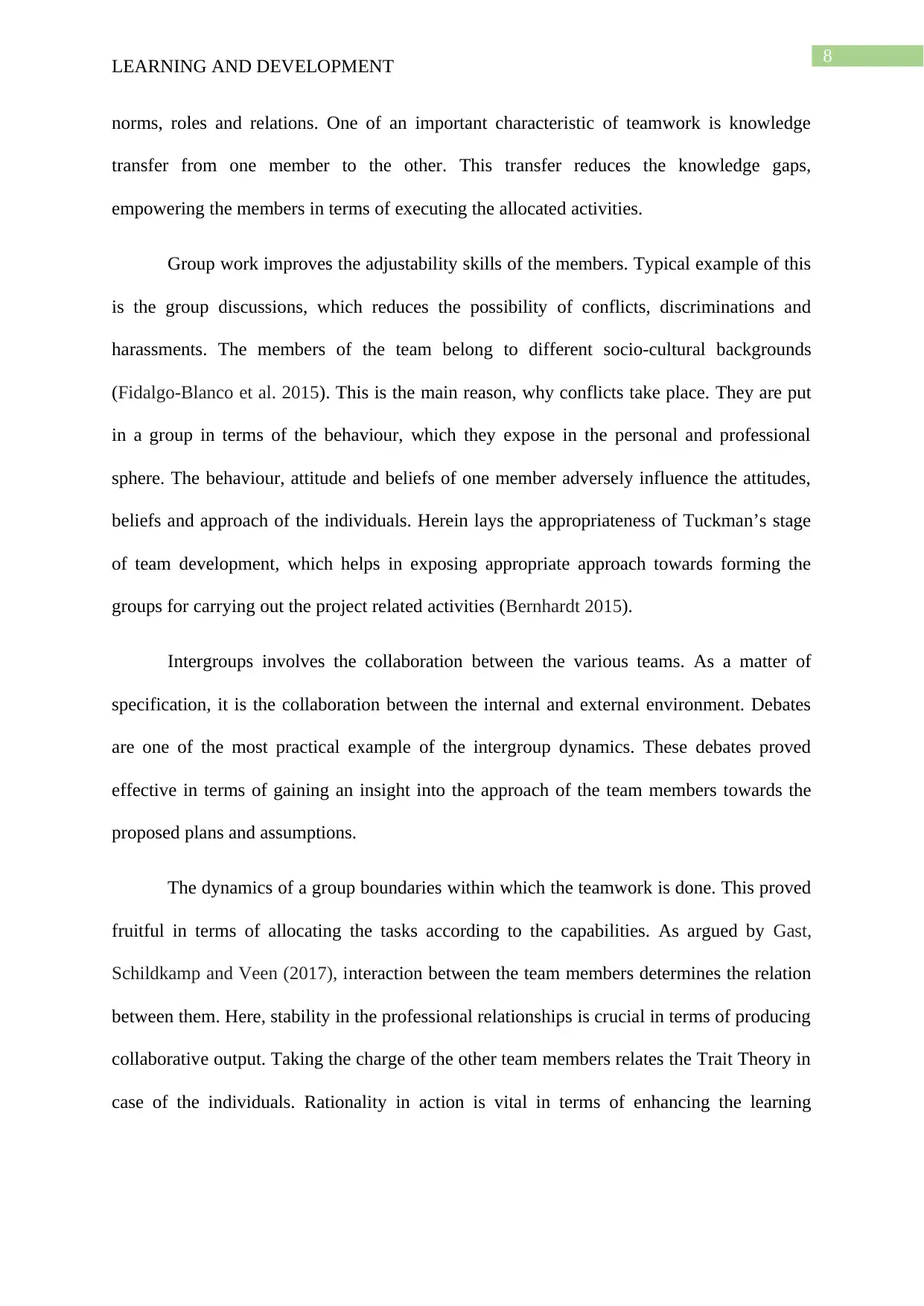
8
LEARNING AND DEVELOPMENT
norms, roles and relations. One of an important characteristic of teamwork is knowledge
transfer from one member to the other. This transfer reduces the knowledge gaps,
empowering the members in terms of executing the allocated activities.
Group work improves the adjustability skills of the members. Typical example of this
is the group discussions, which reduces the possibility of conflicts, discriminations and
harassments. The members of the team belong to different socio-cultural backgrounds
(Fidalgo-Blanco et al. 2015). This is the main reason, why conflicts take place. They are put
in a group in terms of the behaviour, which they expose in the personal and professional
sphere. The behaviour, attitude and beliefs of one member adversely influence the attitudes,
beliefs and approach of the individuals. Herein lays the appropriateness of Tuckman’s stage
of team development, which helps in exposing appropriate approach towards forming the
groups for carrying out the project related activities (Bernhardt 2015).
Intergroups involves the collaboration between the various teams. As a matter of
specification, it is the collaboration between the internal and external environment. Debates
are one of the most practical example of the intergroup dynamics. These debates proved
effective in terms of gaining an insight into the approach of the team members towards the
proposed plans and assumptions.
The dynamics of a group boundaries within which the teamwork is done. This proved
fruitful in terms of allocating the tasks according to the capabilities. As argued by Gast,
Schildkamp and Veen (2017), interaction between the team members determines the relation
between them. Here, stability in the professional relationships is crucial in terms of producing
collaborative output. Taking the charge of the other team members relates the Trait Theory in
case of the individuals. Rationality in action is vital in terms of enhancing the learning
LEARNING AND DEVELOPMENT
norms, roles and relations. One of an important characteristic of teamwork is knowledge
transfer from one member to the other. This transfer reduces the knowledge gaps,
empowering the members in terms of executing the allocated activities.
Group work improves the adjustability skills of the members. Typical example of this
is the group discussions, which reduces the possibility of conflicts, discriminations and
harassments. The members of the team belong to different socio-cultural backgrounds
(Fidalgo-Blanco et al. 2015). This is the main reason, why conflicts take place. They are put
in a group in terms of the behaviour, which they expose in the personal and professional
sphere. The behaviour, attitude and beliefs of one member adversely influence the attitudes,
beliefs and approach of the individuals. Herein lays the appropriateness of Tuckman’s stage
of team development, which helps in exposing appropriate approach towards forming the
groups for carrying out the project related activities (Bernhardt 2015).
Intergroups involves the collaboration between the various teams. As a matter of
specification, it is the collaboration between the internal and external environment. Debates
are one of the most practical example of the intergroup dynamics. These debates proved
effective in terms of gaining an insight into the approach of the team members towards the
proposed plans and assumptions.
The dynamics of a group boundaries within which the teamwork is done. This proved
fruitful in terms of allocating the tasks according to the capabilities. As argued by Gast,
Schildkamp and Veen (2017), interaction between the team members determines the relation
between them. Here, stability in the professional relationships is crucial in terms of producing
collaborative output. Taking the charge of the other team members relates the Trait Theory in
case of the individuals. Rationality in action is vital in terms of enhancing the learning
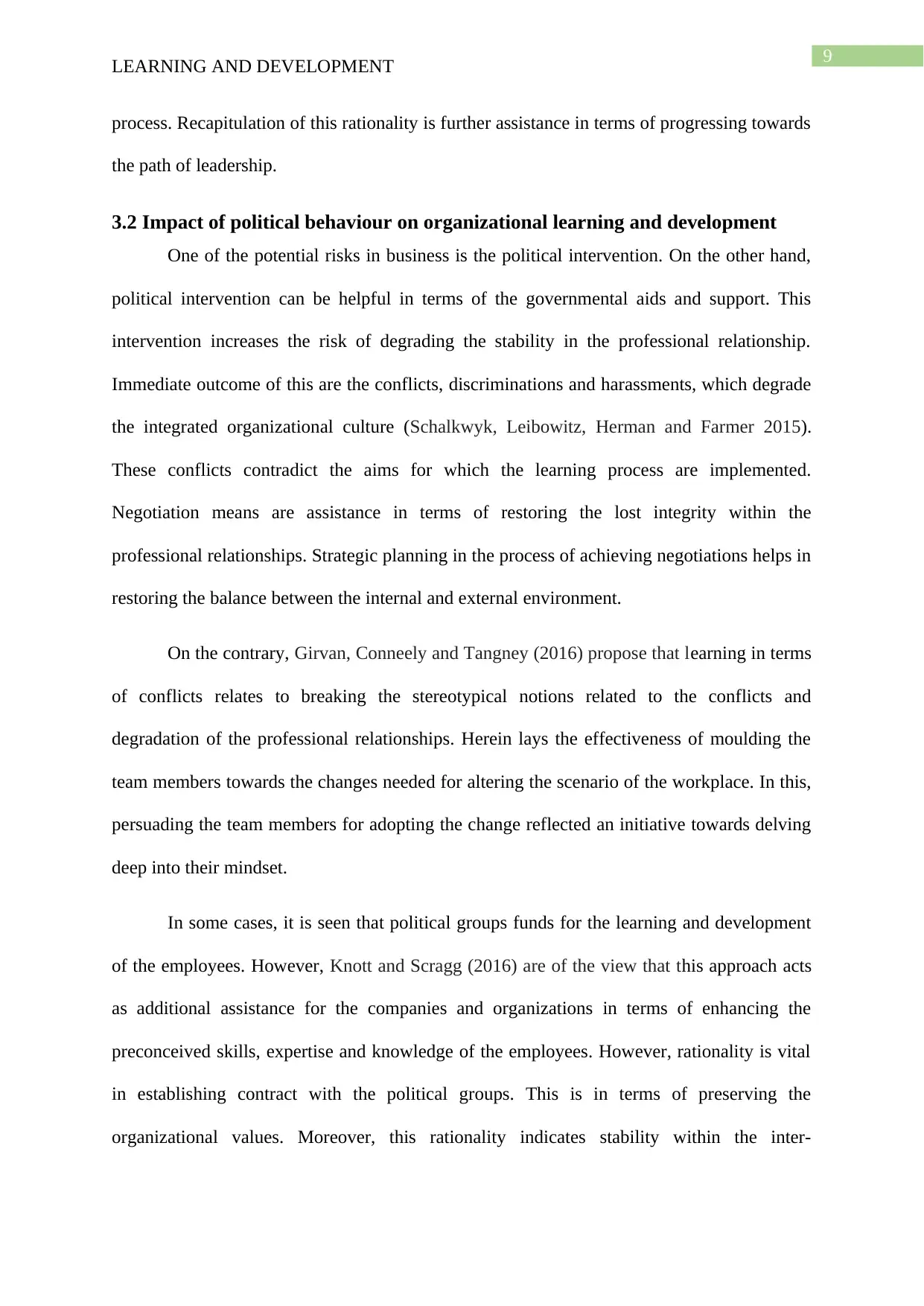
9
LEARNING AND DEVELOPMENT
process. Recapitulation of this rationality is further assistance in terms of progressing towards
the path of leadership.
3.2 Impact of political behaviour on organizational learning and development
One of the potential risks in business is the political intervention. On the other hand,
political intervention can be helpful in terms of the governmental aids and support. This
intervention increases the risk of degrading the stability in the professional relationship.
Immediate outcome of this are the conflicts, discriminations and harassments, which degrade
the integrated organizational culture (Schalkwyk, Leibowitz, Herman and Farmer 2015).
These conflicts contradict the aims for which the learning process are implemented.
Negotiation means are assistance in terms of restoring the lost integrity within the
professional relationships. Strategic planning in the process of achieving negotiations helps in
restoring the balance between the internal and external environment.
On the contrary, Girvan, Conneely and Tangney (2016) propose that learning in terms
of conflicts relates to breaking the stereotypical notions related to the conflicts and
degradation of the professional relationships. Herein lays the effectiveness of moulding the
team members towards the changes needed for altering the scenario of the workplace. In this,
persuading the team members for adopting the change reflected an initiative towards delving
deep into their mindset.
In some cases, it is seen that political groups funds for the learning and development
of the employees. However, Knott and Scragg (2016) are of the view that this approach acts
as additional assistance for the companies and organizations in terms of enhancing the
preconceived skills, expertise and knowledge of the employees. However, rationality is vital
in establishing contract with the political groups. This is in terms of preserving the
organizational values. Moreover, this rationality indicates stability within the inter-
LEARNING AND DEVELOPMENT
process. Recapitulation of this rationality is further assistance in terms of progressing towards
the path of leadership.
3.2 Impact of political behaviour on organizational learning and development
One of the potential risks in business is the political intervention. On the other hand,
political intervention can be helpful in terms of the governmental aids and support. This
intervention increases the risk of degrading the stability in the professional relationship.
Immediate outcome of this are the conflicts, discriminations and harassments, which degrade
the integrated organizational culture (Schalkwyk, Leibowitz, Herman and Farmer 2015).
These conflicts contradict the aims for which the learning process are implemented.
Negotiation means are assistance in terms of restoring the lost integrity within the
professional relationships. Strategic planning in the process of achieving negotiations helps in
restoring the balance between the internal and external environment.
On the contrary, Girvan, Conneely and Tangney (2016) propose that learning in terms
of conflicts relates to breaking the stereotypical notions related to the conflicts and
degradation of the professional relationships. Herein lays the effectiveness of moulding the
team members towards the changes needed for altering the scenario of the workplace. In this,
persuading the team members for adopting the change reflected an initiative towards delving
deep into their mindset.
In some cases, it is seen that political groups funds for the learning and development
of the employees. However, Knott and Scragg (2016) are of the view that this approach acts
as additional assistance for the companies and organizations in terms of enhancing the
preconceived skills, expertise and knowledge of the employees. However, rationality is vital
in establishing contract with the political groups. This is in terms of preserving the
organizational values. Moreover, this rationality indicates stability within the inter-
Secure Best Marks with AI Grader
Need help grading? Try our AI Grader for instant feedback on your assignments.
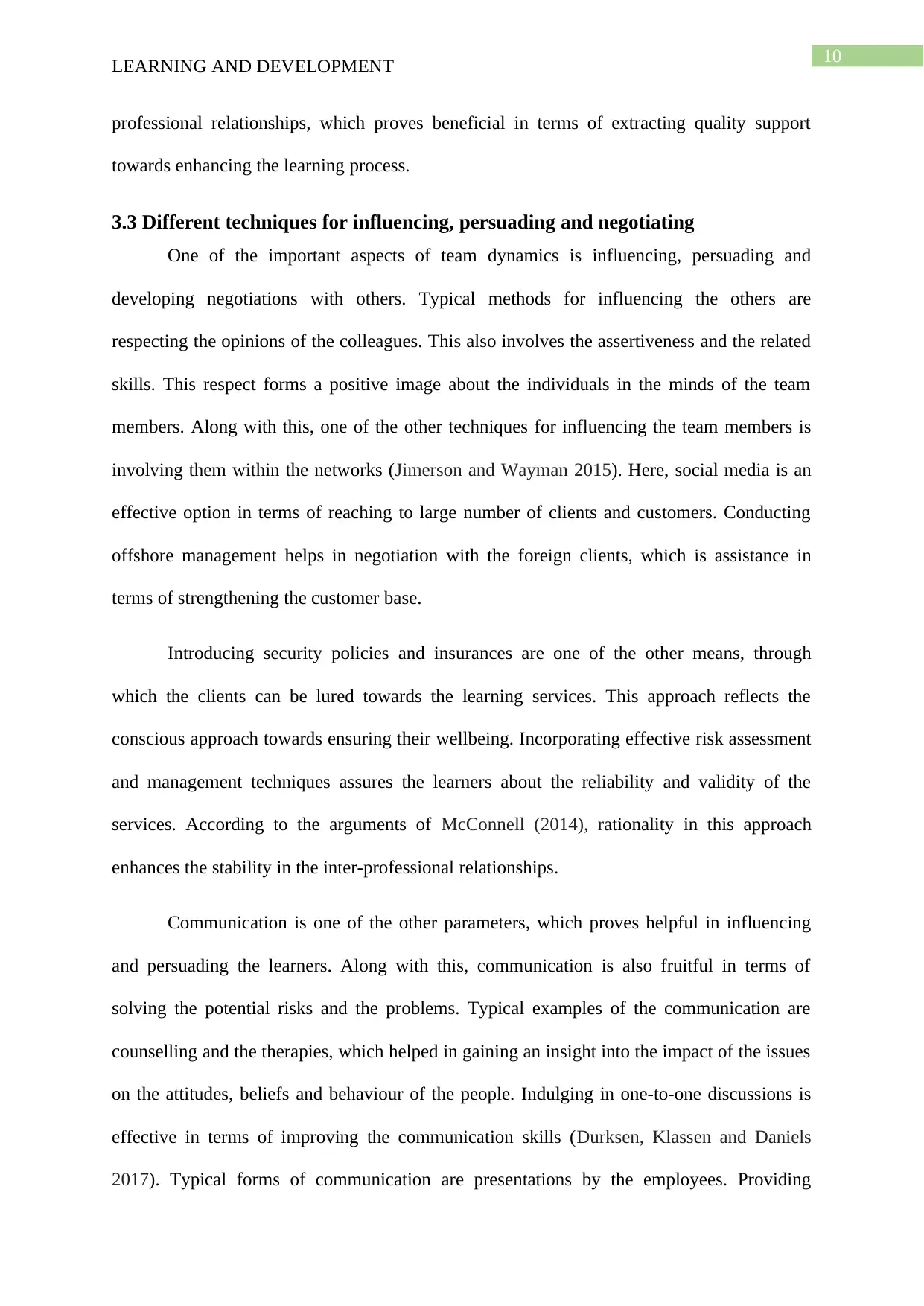
10
LEARNING AND DEVELOPMENT
professional relationships, which proves beneficial in terms of extracting quality support
towards enhancing the learning process.
3.3 Different techniques for influencing, persuading and negotiating
One of the important aspects of team dynamics is influencing, persuading and
developing negotiations with others. Typical methods for influencing the others are
respecting the opinions of the colleagues. This also involves the assertiveness and the related
skills. This respect forms a positive image about the individuals in the minds of the team
members. Along with this, one of the other techniques for influencing the team members is
involving them within the networks (Jimerson and Wayman 2015). Here, social media is an
effective option in terms of reaching to large number of clients and customers. Conducting
offshore management helps in negotiation with the foreign clients, which is assistance in
terms of strengthening the customer base.
Introducing security policies and insurances are one of the other means, through
which the clients can be lured towards the learning services. This approach reflects the
conscious approach towards ensuring their wellbeing. Incorporating effective risk assessment
and management techniques assures the learners about the reliability and validity of the
services. According to the arguments of McConnell (2014), rationality in this approach
enhances the stability in the inter-professional relationships.
Communication is one of the other parameters, which proves helpful in influencing
and persuading the learners. Along with this, communication is also fruitful in terms of
solving the potential risks and the problems. Typical examples of the communication are
counselling and the therapies, which helped in gaining an insight into the impact of the issues
on the attitudes, beliefs and behaviour of the people. Indulging in one-to-one discussions is
effective in terms of improving the communication skills (Durksen, Klassen and Daniels
2017). Typical forms of communication are presentations by the employees. Providing
LEARNING AND DEVELOPMENT
professional relationships, which proves beneficial in terms of extracting quality support
towards enhancing the learning process.
3.3 Different techniques for influencing, persuading and negotiating
One of the important aspects of team dynamics is influencing, persuading and
developing negotiations with others. Typical methods for influencing the others are
respecting the opinions of the colleagues. This also involves the assertiveness and the related
skills. This respect forms a positive image about the individuals in the minds of the team
members. Along with this, one of the other techniques for influencing the team members is
involving them within the networks (Jimerson and Wayman 2015). Here, social media is an
effective option in terms of reaching to large number of clients and customers. Conducting
offshore management helps in negotiation with the foreign clients, which is assistance in
terms of strengthening the customer base.
Introducing security policies and insurances are one of the other means, through
which the clients can be lured towards the learning services. This approach reflects the
conscious approach towards ensuring their wellbeing. Incorporating effective risk assessment
and management techniques assures the learners about the reliability and validity of the
services. According to the arguments of McConnell (2014), rationality in this approach
enhances the stability in the inter-professional relationships.
Communication is one of the other parameters, which proves helpful in influencing
and persuading the learners. Along with this, communication is also fruitful in terms of
solving the potential risks and the problems. Typical examples of the communication are
counselling and the therapies, which helped in gaining an insight into the impact of the issues
on the attitudes, beliefs and behaviour of the people. Indulging in one-to-one discussions is
effective in terms of improving the communication skills (Durksen, Klassen and Daniels
2017). Typical forms of communication are presentations by the employees. Providing
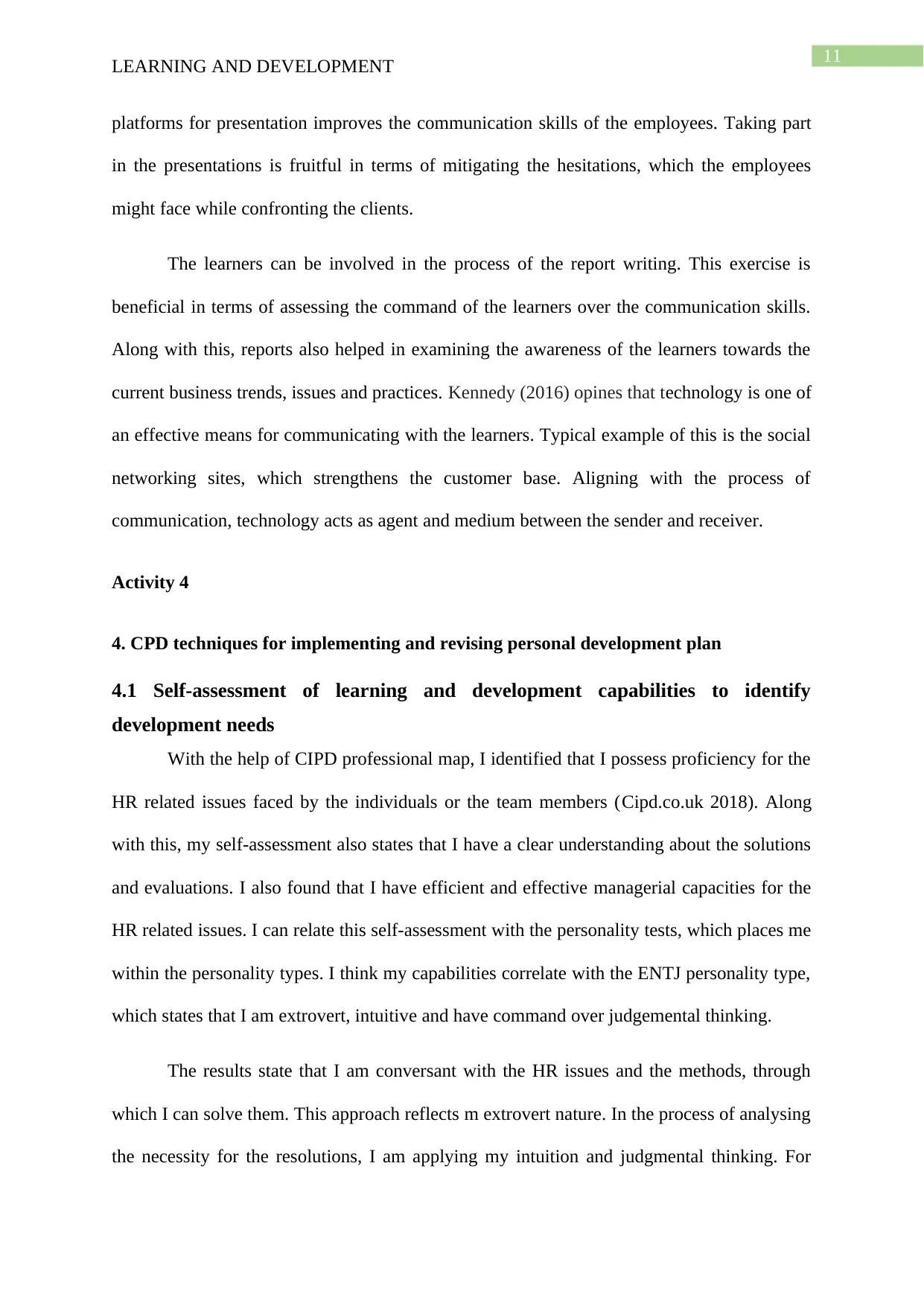
11
LEARNING AND DEVELOPMENT
platforms for presentation improves the communication skills of the employees. Taking part
in the presentations is fruitful in terms of mitigating the hesitations, which the employees
might face while confronting the clients.
The learners can be involved in the process of the report writing. This exercise is
beneficial in terms of assessing the command of the learners over the communication skills.
Along with this, reports also helped in examining the awareness of the learners towards the
current business trends, issues and practices. Kennedy (2016) opines that technology is one of
an effective means for communicating with the learners. Typical example of this is the social
networking sites, which strengthens the customer base. Aligning with the process of
communication, technology acts as agent and medium between the sender and receiver.
Activity 4
4. CPD techniques for implementing and revising personal development plan
4.1 Self-assessment of learning and development capabilities to identify
development needs
With the help of CIPD professional map, I identified that I possess proficiency for the
HR related issues faced by the individuals or the team members (Cipd.co.uk 2018). Along
with this, my self-assessment also states that I have a clear understanding about the solutions
and evaluations. I also found that I have efficient and effective managerial capacities for the
HR related issues. I can relate this self-assessment with the personality tests, which places me
within the personality types. I think my capabilities correlate with the ENTJ personality type,
which states that I am extrovert, intuitive and have command over judgemental thinking.
The results state that I am conversant with the HR issues and the methods, through
which I can solve them. This approach reflects m extrovert nature. In the process of analysing
the necessity for the resolutions, I am applying my intuition and judgmental thinking. For
LEARNING AND DEVELOPMENT
platforms for presentation improves the communication skills of the employees. Taking part
in the presentations is fruitful in terms of mitigating the hesitations, which the employees
might face while confronting the clients.
The learners can be involved in the process of the report writing. This exercise is
beneficial in terms of assessing the command of the learners over the communication skills.
Along with this, reports also helped in examining the awareness of the learners towards the
current business trends, issues and practices. Kennedy (2016) opines that technology is one of
an effective means for communicating with the learners. Typical example of this is the social
networking sites, which strengthens the customer base. Aligning with the process of
communication, technology acts as agent and medium between the sender and receiver.
Activity 4
4. CPD techniques for implementing and revising personal development plan
4.1 Self-assessment of learning and development capabilities to identify
development needs
With the help of CIPD professional map, I identified that I possess proficiency for the
HR related issues faced by the individuals or the team members (Cipd.co.uk 2018). Along
with this, my self-assessment also states that I have a clear understanding about the solutions
and evaluations. I also found that I have efficient and effective managerial capacities for the
HR related issues. I can relate this self-assessment with the personality tests, which places me
within the personality types. I think my capabilities correlate with the ENTJ personality type,
which states that I am extrovert, intuitive and have command over judgemental thinking.
The results state that I am conversant with the HR issues and the methods, through
which I can solve them. This approach reflects m extrovert nature. In the process of analysing
the necessity for the resolutions, I am applying my intuition and judgmental thinking. For
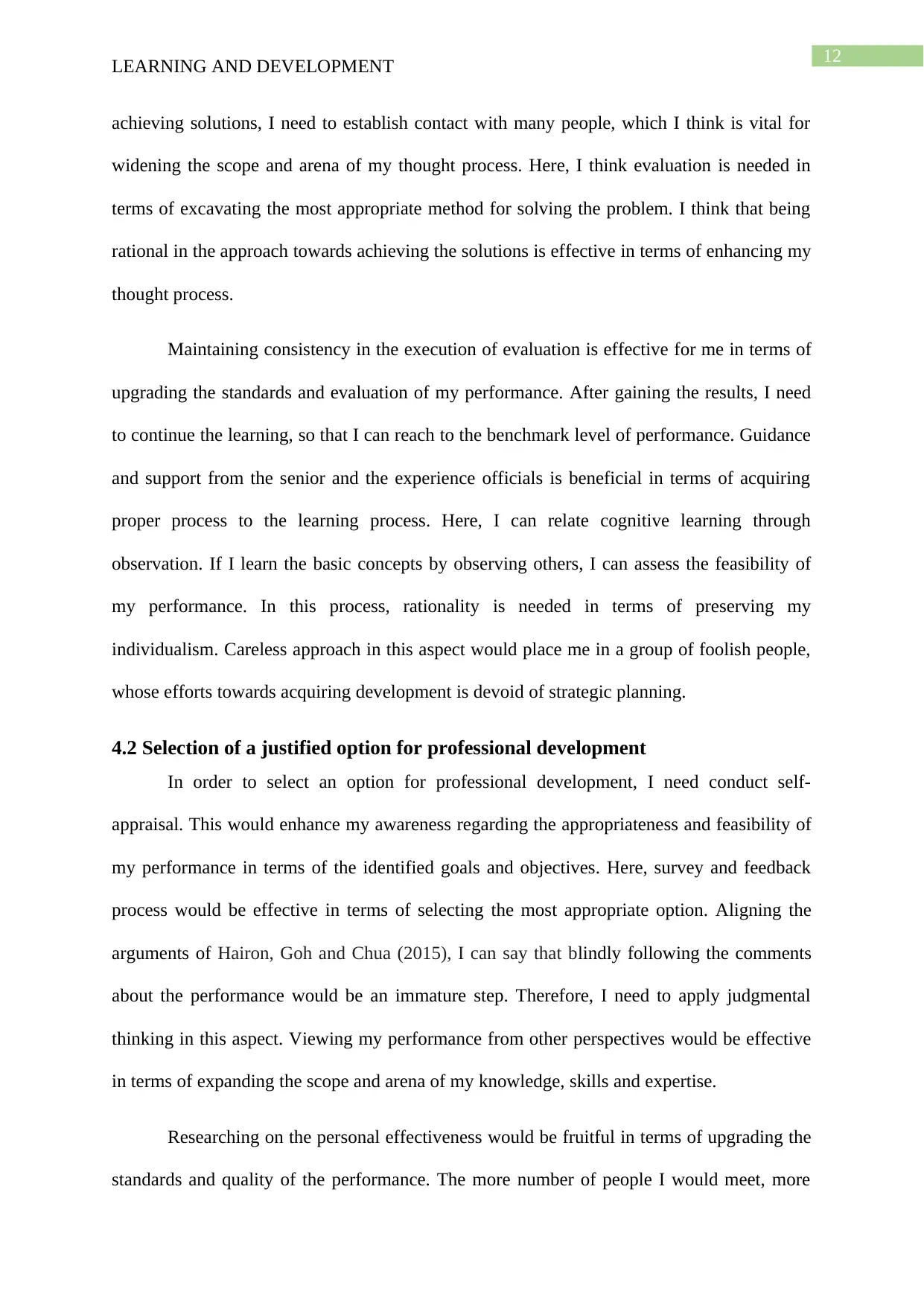
12
LEARNING AND DEVELOPMENT
achieving solutions, I need to establish contact with many people, which I think is vital for
widening the scope and arena of my thought process. Here, I think evaluation is needed in
terms of excavating the most appropriate method for solving the problem. I think that being
rational in the approach towards achieving the solutions is effective in terms of enhancing my
thought process.
Maintaining consistency in the execution of evaluation is effective for me in terms of
upgrading the standards and evaluation of my performance. After gaining the results, I need
to continue the learning, so that I can reach to the benchmark level of performance. Guidance
and support from the senior and the experience officials is beneficial in terms of acquiring
proper process to the learning process. Here, I can relate cognitive learning through
observation. If I learn the basic concepts by observing others, I can assess the feasibility of
my performance. In this process, rationality is needed in terms of preserving my
individualism. Careless approach in this aspect would place me in a group of foolish people,
whose efforts towards acquiring development is devoid of strategic planning.
4.2 Selection of a justified option for professional development
In order to select an option for professional development, I need conduct self-
appraisal. This would enhance my awareness regarding the appropriateness and feasibility of
my performance in terms of the identified goals and objectives. Here, survey and feedback
process would be effective in terms of selecting the most appropriate option. Aligning the
arguments of Hairon, Goh and Chua (2015), I can say that blindly following the comments
about the performance would be an immature step. Therefore, I need to apply judgmental
thinking in this aspect. Viewing my performance from other perspectives would be effective
in terms of expanding the scope and arena of my knowledge, skills and expertise.
Researching on the personal effectiveness would be fruitful in terms of upgrading the
standards and quality of the performance. The more number of people I would meet, more
LEARNING AND DEVELOPMENT
achieving solutions, I need to establish contact with many people, which I think is vital for
widening the scope and arena of my thought process. Here, I think evaluation is needed in
terms of excavating the most appropriate method for solving the problem. I think that being
rational in the approach towards achieving the solutions is effective in terms of enhancing my
thought process.
Maintaining consistency in the execution of evaluation is effective for me in terms of
upgrading the standards and evaluation of my performance. After gaining the results, I need
to continue the learning, so that I can reach to the benchmark level of performance. Guidance
and support from the senior and the experience officials is beneficial in terms of acquiring
proper process to the learning process. Here, I can relate cognitive learning through
observation. If I learn the basic concepts by observing others, I can assess the feasibility of
my performance. In this process, rationality is needed in terms of preserving my
individualism. Careless approach in this aspect would place me in a group of foolish people,
whose efforts towards acquiring development is devoid of strategic planning.
4.2 Selection of a justified option for professional development
In order to select an option for professional development, I need conduct self-
appraisal. This would enhance my awareness regarding the appropriateness and feasibility of
my performance in terms of the identified goals and objectives. Here, survey and feedback
process would be effective in terms of selecting the most appropriate option. Aligning the
arguments of Hairon, Goh and Chua (2015), I can say that blindly following the comments
about the performance would be an immature step. Therefore, I need to apply judgmental
thinking in this aspect. Viewing my performance from other perspectives would be effective
in terms of expanding the scope and arena of my knowledge, skills and expertise.
Researching on the personal effectiveness would be fruitful in terms of upgrading the
standards and quality of the performance. The more number of people I would meet, more
Paraphrase This Document
Need a fresh take? Get an instant paraphrase of this document with our AI Paraphraser
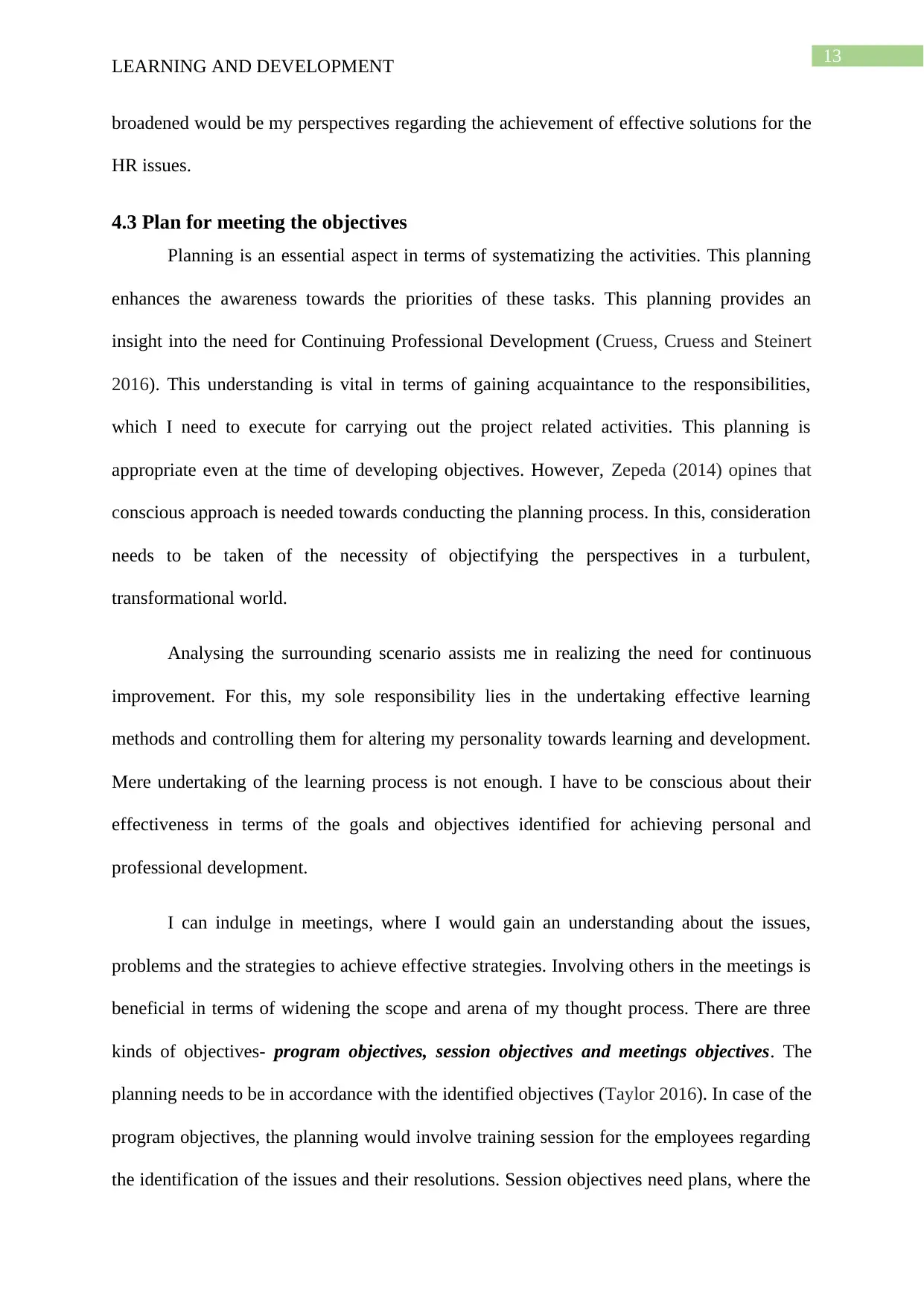
13
LEARNING AND DEVELOPMENT
broadened would be my perspectives regarding the achievement of effective solutions for the
HR issues.
4.3 Plan for meeting the objectives
Planning is an essential aspect in terms of systematizing the activities. This planning
enhances the awareness towards the priorities of these tasks. This planning provides an
insight into the need for Continuing Professional Development (Cruess, Cruess and Steinert
2016). This understanding is vital in terms of gaining acquaintance to the responsibilities,
which I need to execute for carrying out the project related activities. This planning is
appropriate even at the time of developing objectives. However, Zepeda (2014) opines that
conscious approach is needed towards conducting the planning process. In this, consideration
needs to be taken of the necessity of objectifying the perspectives in a turbulent,
transformational world.
Analysing the surrounding scenario assists me in realizing the need for continuous
improvement. For this, my sole responsibility lies in the undertaking effective learning
methods and controlling them for altering my personality towards learning and development.
Mere undertaking of the learning process is not enough. I have to be conscious about their
effectiveness in terms of the goals and objectives identified for achieving personal and
professional development.
I can indulge in meetings, where I would gain an understanding about the issues,
problems and the strategies to achieve effective strategies. Involving others in the meetings is
beneficial in terms of widening the scope and arena of my thought process. There are three
kinds of objectives- program objectives, session objectives and meetings objectives. The
planning needs to be in accordance with the identified objectives (Taylor 2016). In case of the
program objectives, the planning would involve training session for the employees regarding
the identification of the issues and their resolutions. Session objectives need plans, where the
LEARNING AND DEVELOPMENT
broadened would be my perspectives regarding the achievement of effective solutions for the
HR issues.
4.3 Plan for meeting the objectives
Planning is an essential aspect in terms of systematizing the activities. This planning
enhances the awareness towards the priorities of these tasks. This planning provides an
insight into the need for Continuing Professional Development (Cruess, Cruess and Steinert
2016). This understanding is vital in terms of gaining acquaintance to the responsibilities,
which I need to execute for carrying out the project related activities. This planning is
appropriate even at the time of developing objectives. However, Zepeda (2014) opines that
conscious approach is needed towards conducting the planning process. In this, consideration
needs to be taken of the necessity of objectifying the perspectives in a turbulent,
transformational world.
Analysing the surrounding scenario assists me in realizing the need for continuous
improvement. For this, my sole responsibility lies in the undertaking effective learning
methods and controlling them for altering my personality towards learning and development.
Mere undertaking of the learning process is not enough. I have to be conscious about their
effectiveness in terms of the goals and objectives identified for achieving personal and
professional development.
I can indulge in meetings, where I would gain an understanding about the issues,
problems and the strategies to achieve effective strategies. Involving others in the meetings is
beneficial in terms of widening the scope and arena of my thought process. There are three
kinds of objectives- program objectives, session objectives and meetings objectives. The
planning needs to be in accordance with the identified objectives (Taylor 2016). In case of the
program objectives, the planning would involve training session for the employees regarding
the identification of the issues and their resolutions. Session objectives need plans, where the
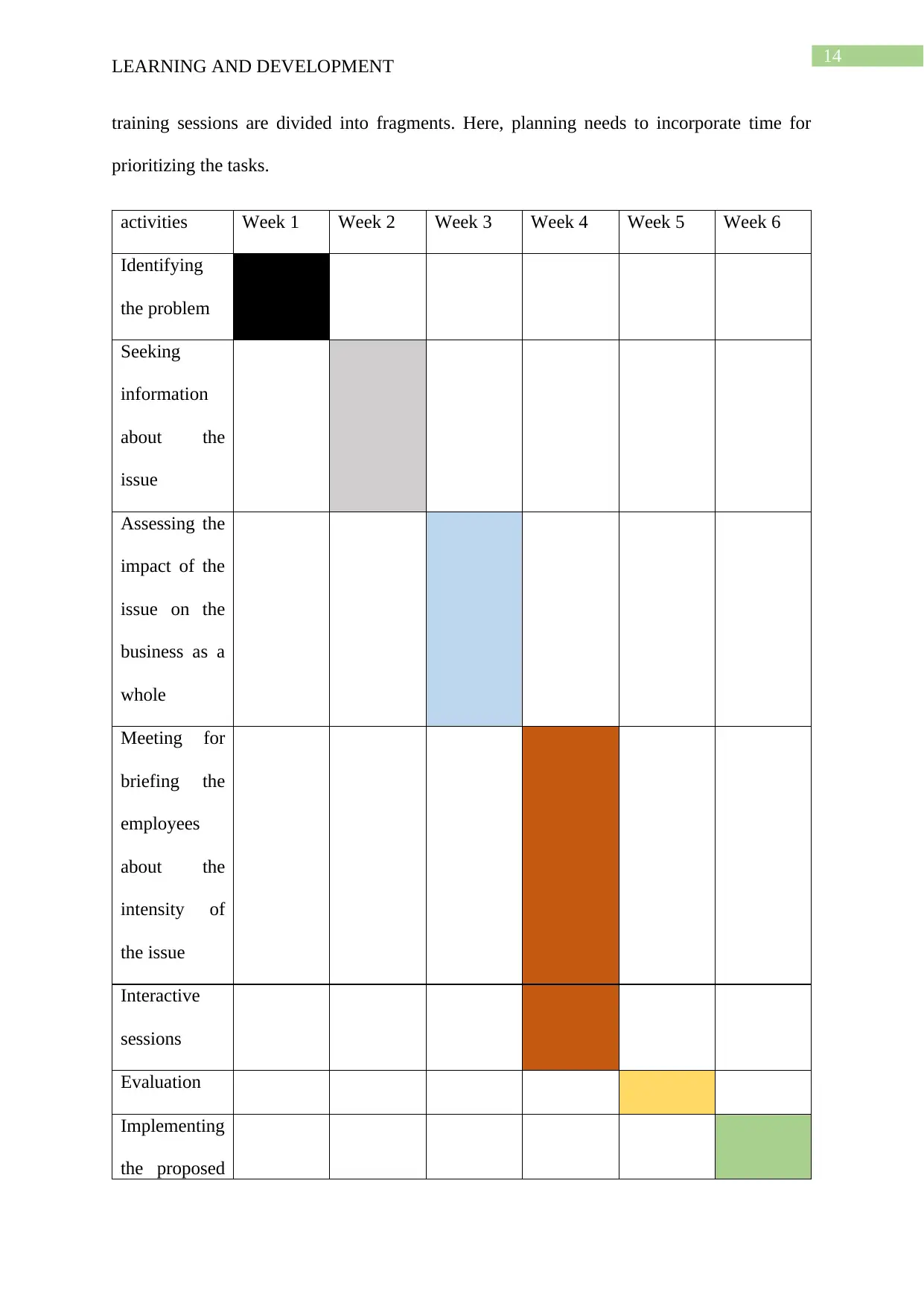
14
LEARNING AND DEVELOPMENT
training sessions are divided into fragments. Here, planning needs to incorporate time for
prioritizing the tasks.
activities Week 1 Week 2 Week 3 Week 4 Week 5 Week 6
Identifying
the problem
Seeking
information
about the
issue
Assessing the
impact of the
issue on the
business as a
whole
Meeting for
briefing the
employees
about the
intensity of
the issue
Interactive
sessions
Evaluation
Implementing
the proposed
LEARNING AND DEVELOPMENT
training sessions are divided into fragments. Here, planning needs to incorporate time for
prioritizing the tasks.
activities Week 1 Week 2 Week 3 Week 4 Week 5 Week 6
Identifying
the problem
Seeking
information
about the
issue
Assessing the
impact of the
issue on the
business as a
whole
Meeting for
briefing the
employees
about the
intensity of
the issue
Interactive
sessions
Evaluation
Implementing
the proposed
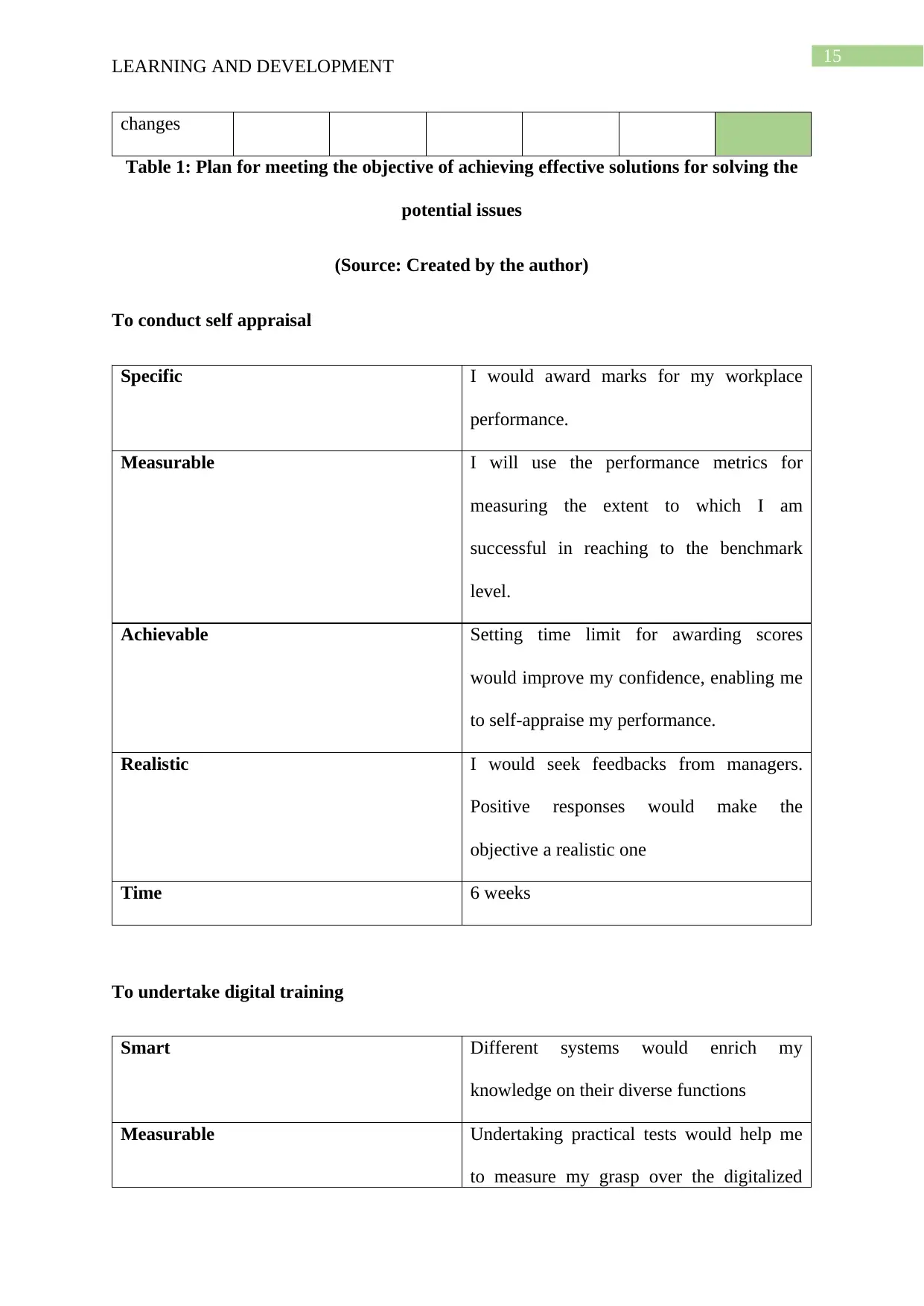
15
LEARNING AND DEVELOPMENT
changes
Table 1: Plan for meeting the objective of achieving effective solutions for solving the
potential issues
(Source: Created by the author)
To conduct self appraisal
Specific I would award marks for my workplace
performance.
Measurable I will use the performance metrics for
measuring the extent to which I am
successful in reaching to the benchmark
level.
Achievable Setting time limit for awarding scores
would improve my confidence, enabling me
to self-appraise my performance.
Realistic I would seek feedbacks from managers.
Positive responses would make the
objective a realistic one
Time 6 weeks
To undertake digital training
Smart Different systems would enrich my
knowledge on their diverse functions
Measurable Undertaking practical tests would help me
to measure my grasp over the digitalized
LEARNING AND DEVELOPMENT
changes
Table 1: Plan for meeting the objective of achieving effective solutions for solving the
potential issues
(Source: Created by the author)
To conduct self appraisal
Specific I would award marks for my workplace
performance.
Measurable I will use the performance metrics for
measuring the extent to which I am
successful in reaching to the benchmark
level.
Achievable Setting time limit for awarding scores
would improve my confidence, enabling me
to self-appraise my performance.
Realistic I would seek feedbacks from managers.
Positive responses would make the
objective a realistic one
Time 6 weeks
To undertake digital training
Smart Different systems would enrich my
knowledge on their diverse functions
Measurable Undertaking practical tests would help me
to measure my grasp over the digitalized
Secure Best Marks with AI Grader
Need help grading? Try our AI Grader for instant feedback on your assignments.
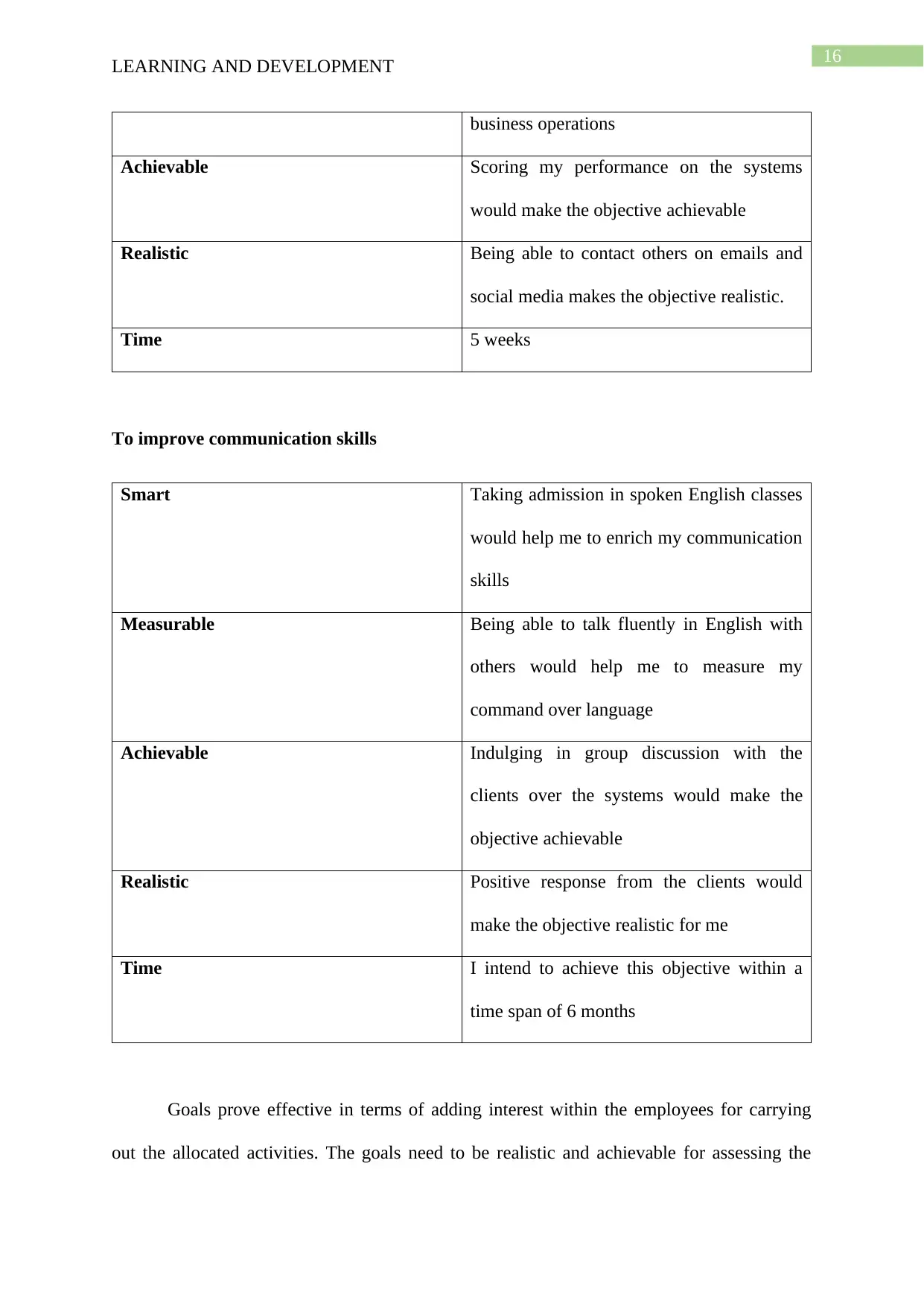
16
LEARNING AND DEVELOPMENT
business operations
Achievable Scoring my performance on the systems
would make the objective achievable
Realistic Being able to contact others on emails and
social media makes the objective realistic.
Time 5 weeks
To improve communication skills
Smart Taking admission in spoken English classes
would help me to enrich my communication
skills
Measurable Being able to talk fluently in English with
others would help me to measure my
command over language
Achievable Indulging in group discussion with the
clients over the systems would make the
objective achievable
Realistic Positive response from the clients would
make the objective realistic for me
Time I intend to achieve this objective within a
time span of 6 months
Goals prove effective in terms of adding interest within the employees for carrying
out the allocated activities. The goals need to be realistic and achievable for assessing the
LEARNING AND DEVELOPMENT
business operations
Achievable Scoring my performance on the systems
would make the objective achievable
Realistic Being able to contact others on emails and
social media makes the objective realistic.
Time 5 weeks
To improve communication skills
Smart Taking admission in spoken English classes
would help me to enrich my communication
skills
Measurable Being able to talk fluently in English with
others would help me to measure my
command over language
Achievable Indulging in group discussion with the
clients over the systems would make the
objective achievable
Realistic Positive response from the clients would
make the objective realistic for me
Time I intend to achieve this objective within a
time span of 6 months
Goals prove effective in terms of adding interest within the employees for carrying
out the allocated activities. The goals need to be realistic and achievable for assessing the
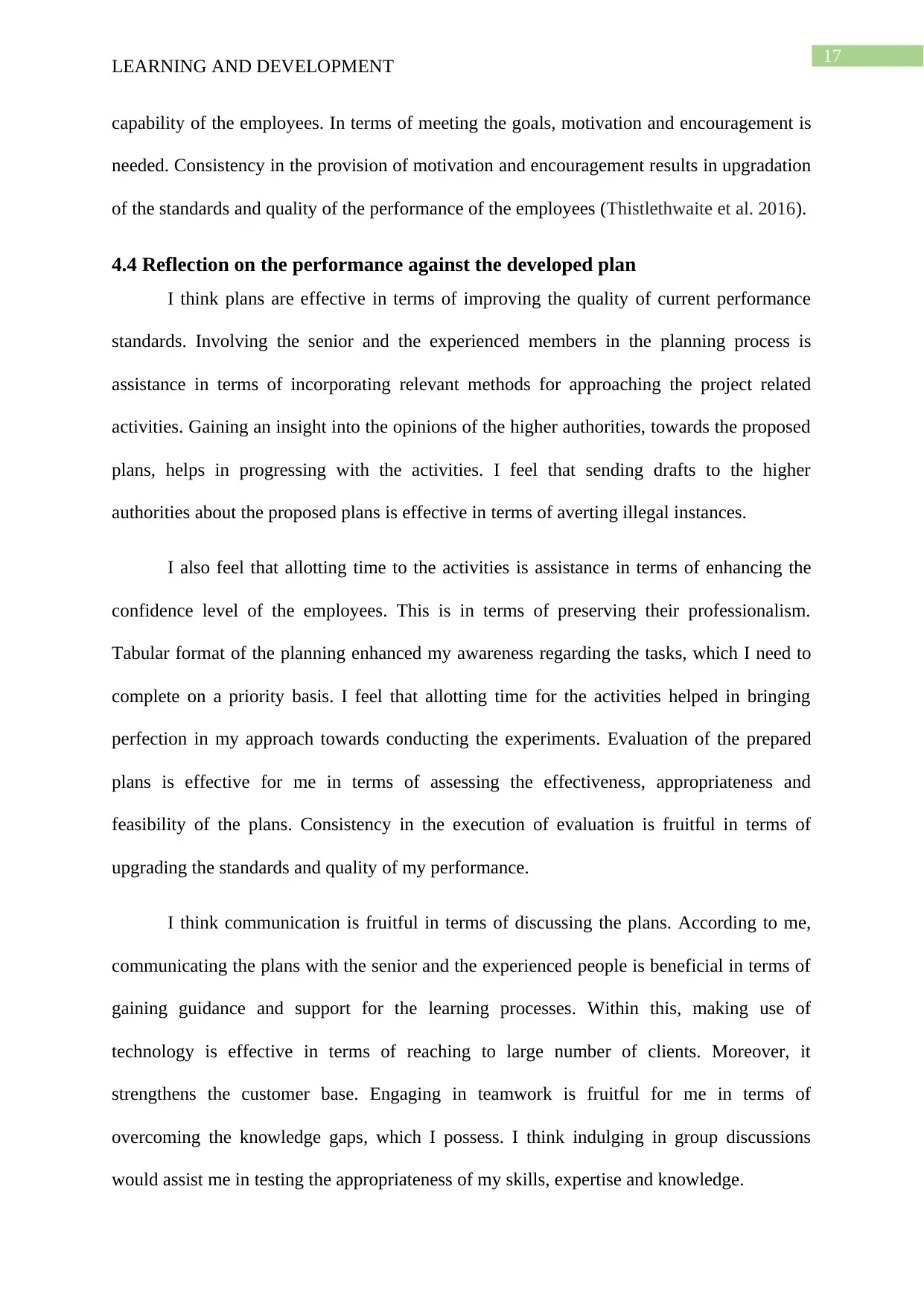
17
LEARNING AND DEVELOPMENT
capability of the employees. In terms of meeting the goals, motivation and encouragement is
needed. Consistency in the provision of motivation and encouragement results in upgradation
of the standards and quality of the performance of the employees (Thistlethwaite et al. 2016).
4.4 Reflection on the performance against the developed plan
I think plans are effective in terms of improving the quality of current performance
standards. Involving the senior and the experienced members in the planning process is
assistance in terms of incorporating relevant methods for approaching the project related
activities. Gaining an insight into the opinions of the higher authorities, towards the proposed
plans, helps in progressing with the activities. I feel that sending drafts to the higher
authorities about the proposed plans is effective in terms of averting illegal instances.
I also feel that allotting time to the activities is assistance in terms of enhancing the
confidence level of the employees. This is in terms of preserving their professionalism.
Tabular format of the planning enhanced my awareness regarding the tasks, which I need to
complete on a priority basis. I feel that allotting time for the activities helped in bringing
perfection in my approach towards conducting the experiments. Evaluation of the prepared
plans is effective for me in terms of assessing the effectiveness, appropriateness and
feasibility of the plans. Consistency in the execution of evaluation is fruitful in terms of
upgrading the standards and quality of my performance.
I think communication is fruitful in terms of discussing the plans. According to me,
communicating the plans with the senior and the experienced people is beneficial in terms of
gaining guidance and support for the learning processes. Within this, making use of
technology is effective in terms of reaching to large number of clients. Moreover, it
strengthens the customer base. Engaging in teamwork is fruitful for me in terms of
overcoming the knowledge gaps, which I possess. I think indulging in group discussions
would assist me in testing the appropriateness of my skills, expertise and knowledge.
LEARNING AND DEVELOPMENT
capability of the employees. In terms of meeting the goals, motivation and encouragement is
needed. Consistency in the provision of motivation and encouragement results in upgradation
of the standards and quality of the performance of the employees (Thistlethwaite et al. 2016).
4.4 Reflection on the performance against the developed plan
I think plans are effective in terms of improving the quality of current performance
standards. Involving the senior and the experienced members in the planning process is
assistance in terms of incorporating relevant methods for approaching the project related
activities. Gaining an insight into the opinions of the higher authorities, towards the proposed
plans, helps in progressing with the activities. I feel that sending drafts to the higher
authorities about the proposed plans is effective in terms of averting illegal instances.
I also feel that allotting time to the activities is assistance in terms of enhancing the
confidence level of the employees. This is in terms of preserving their professionalism.
Tabular format of the planning enhanced my awareness regarding the tasks, which I need to
complete on a priority basis. I feel that allotting time for the activities helped in bringing
perfection in my approach towards conducting the experiments. Evaluation of the prepared
plans is effective for me in terms of assessing the effectiveness, appropriateness and
feasibility of the plans. Consistency in the execution of evaluation is fruitful in terms of
upgrading the standards and quality of my performance.
I think communication is fruitful in terms of discussing the plans. According to me,
communicating the plans with the senior and the experienced people is beneficial in terms of
gaining guidance and support for the learning processes. Within this, making use of
technology is effective in terms of reaching to large number of clients. Moreover, it
strengthens the customer base. Engaging in teamwork is fruitful for me in terms of
overcoming the knowledge gaps, which I possess. I think indulging in group discussions
would assist me in testing the appropriateness of my skills, expertise and knowledge.
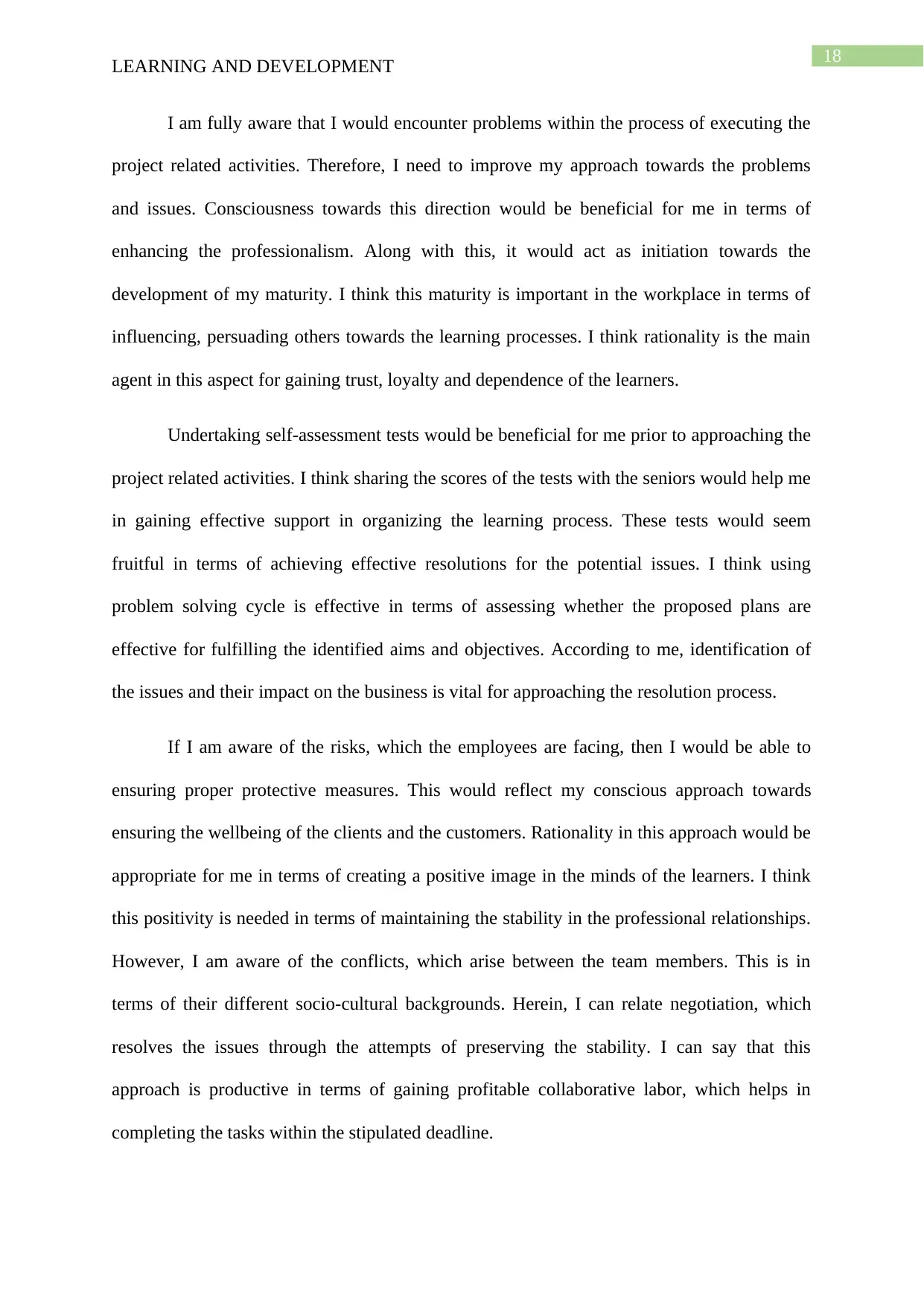
18
LEARNING AND DEVELOPMENT
I am fully aware that I would encounter problems within the process of executing the
project related activities. Therefore, I need to improve my approach towards the problems
and issues. Consciousness towards this direction would be beneficial for me in terms of
enhancing the professionalism. Along with this, it would act as initiation towards the
development of my maturity. I think this maturity is important in the workplace in terms of
influencing, persuading others towards the learning processes. I think rationality is the main
agent in this aspect for gaining trust, loyalty and dependence of the learners.
Undertaking self-assessment tests would be beneficial for me prior to approaching the
project related activities. I think sharing the scores of the tests with the seniors would help me
in gaining effective support in organizing the learning process. These tests would seem
fruitful in terms of achieving effective resolutions for the potential issues. I think using
problem solving cycle is effective in terms of assessing whether the proposed plans are
effective for fulfilling the identified aims and objectives. According to me, identification of
the issues and their impact on the business is vital for approaching the resolution process.
If I am aware of the risks, which the employees are facing, then I would be able to
ensuring proper protective measures. This would reflect my conscious approach towards
ensuring the wellbeing of the clients and the customers. Rationality in this approach would be
appropriate for me in terms of creating a positive image in the minds of the learners. I think
this positivity is needed in terms of maintaining the stability in the professional relationships.
However, I am aware of the conflicts, which arise between the team members. This is in
terms of their different socio-cultural backgrounds. Herein, I can relate negotiation, which
resolves the issues through the attempts of preserving the stability. I can say that this
approach is productive in terms of gaining profitable collaborative labor, which helps in
completing the tasks within the stipulated deadline.
LEARNING AND DEVELOPMENT
I am fully aware that I would encounter problems within the process of executing the
project related activities. Therefore, I need to improve my approach towards the problems
and issues. Consciousness towards this direction would be beneficial for me in terms of
enhancing the professionalism. Along with this, it would act as initiation towards the
development of my maturity. I think this maturity is important in the workplace in terms of
influencing, persuading others towards the learning processes. I think rationality is the main
agent in this aspect for gaining trust, loyalty and dependence of the learners.
Undertaking self-assessment tests would be beneficial for me prior to approaching the
project related activities. I think sharing the scores of the tests with the seniors would help me
in gaining effective support in organizing the learning process. These tests would seem
fruitful in terms of achieving effective resolutions for the potential issues. I think using
problem solving cycle is effective in terms of assessing whether the proposed plans are
effective for fulfilling the identified aims and objectives. According to me, identification of
the issues and their impact on the business is vital for approaching the resolution process.
If I am aware of the risks, which the employees are facing, then I would be able to
ensuring proper protective measures. This would reflect my conscious approach towards
ensuring the wellbeing of the clients and the customers. Rationality in this approach would be
appropriate for me in terms of creating a positive image in the minds of the learners. I think
this positivity is needed in terms of maintaining the stability in the professional relationships.
However, I am aware of the conflicts, which arise between the team members. This is in
terms of their different socio-cultural backgrounds. Herein, I can relate negotiation, which
resolves the issues through the attempts of preserving the stability. I can say that this
approach is productive in terms of gaining profitable collaborative labor, which helps in
completing the tasks within the stipulated deadline.
Paraphrase This Document
Need a fresh take? Get an instant paraphrase of this document with our AI Paraphraser
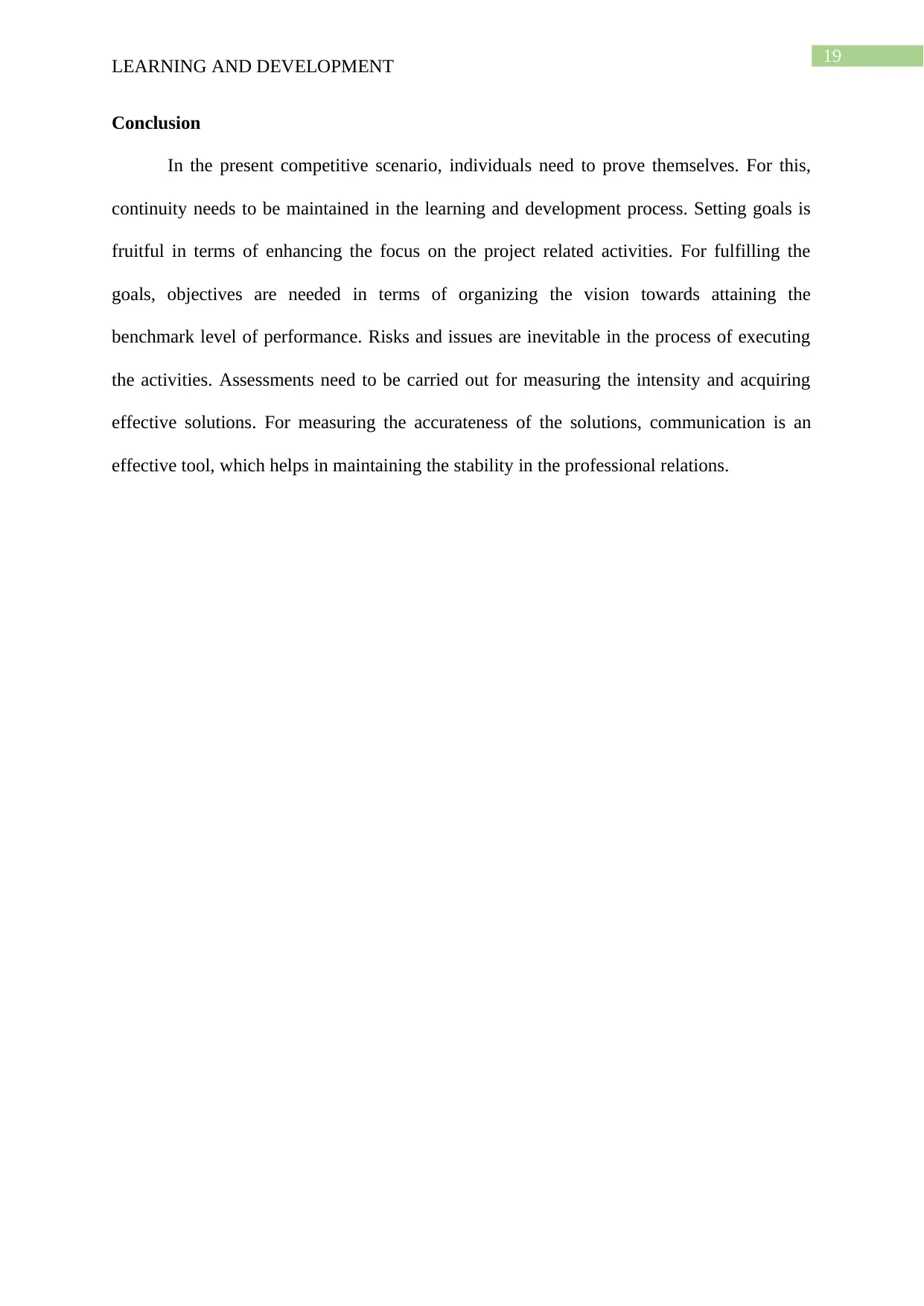
19
LEARNING AND DEVELOPMENT
Conclusion
In the present competitive scenario, individuals need to prove themselves. For this,
continuity needs to be maintained in the learning and development process. Setting goals is
fruitful in terms of enhancing the focus on the project related activities. For fulfilling the
goals, objectives are needed in terms of organizing the vision towards attaining the
benchmark level of performance. Risks and issues are inevitable in the process of executing
the activities. Assessments need to be carried out for measuring the intensity and acquiring
effective solutions. For measuring the accurateness of the solutions, communication is an
effective tool, which helps in maintaining the stability in the professional relations.
LEARNING AND DEVELOPMENT
Conclusion
In the present competitive scenario, individuals need to prove themselves. For this,
continuity needs to be maintained in the learning and development process. Setting goals is
fruitful in terms of enhancing the focus on the project related activities. For fulfilling the
goals, objectives are needed in terms of organizing the vision towards attaining the
benchmark level of performance. Risks and issues are inevitable in the process of executing
the activities. Assessments need to be carried out for measuring the intensity and acquiring
effective solutions. For measuring the accurateness of the solutions, communication is an
effective tool, which helps in maintaining the stability in the professional relations.
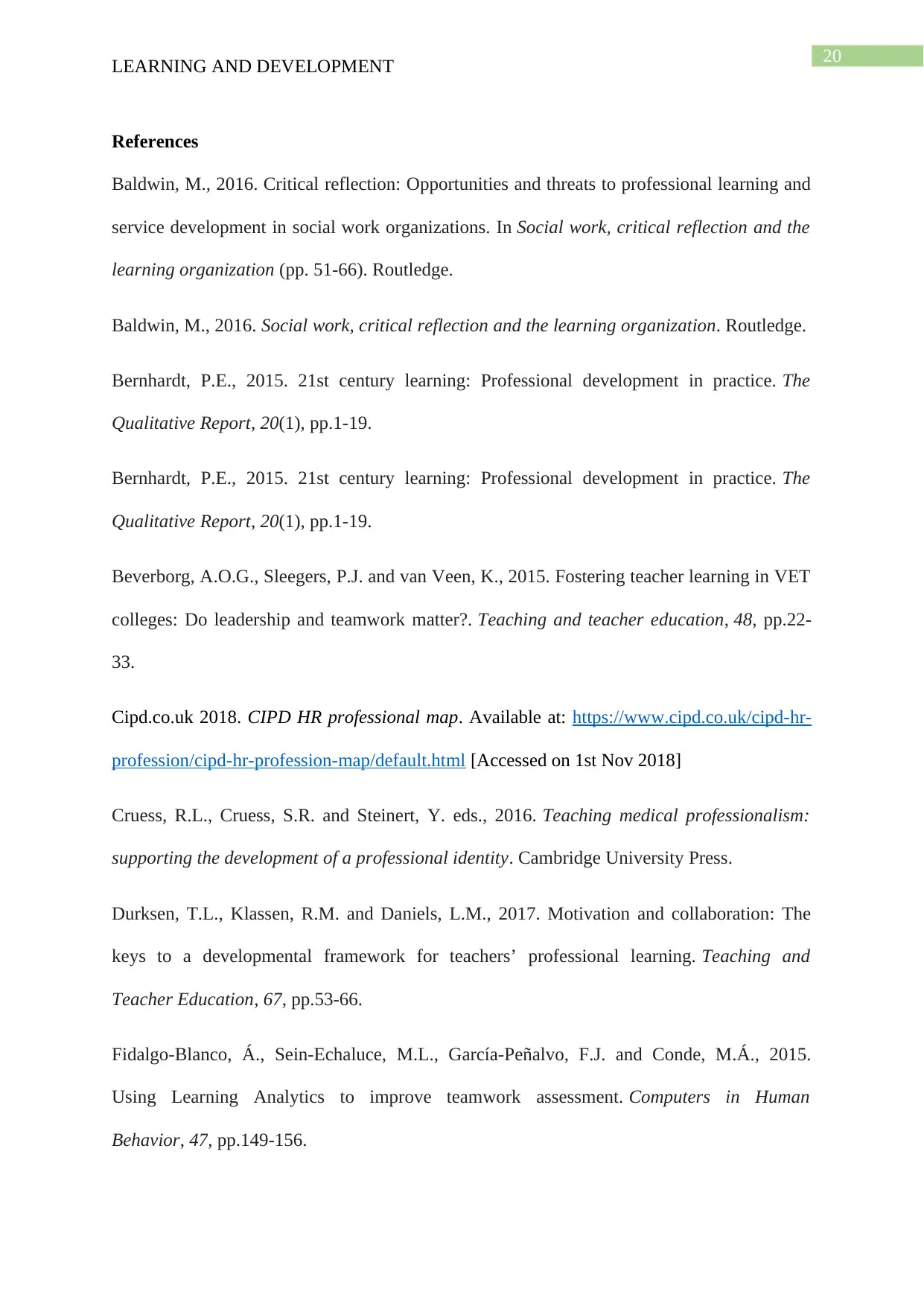
20
LEARNING AND DEVELOPMENT
References
Baldwin, M., 2016. Critical reflection: Opportunities and threats to professional learning and
service development in social work organizations. In Social work, critical reflection and the
learning organization (pp. 51-66). Routledge.
Baldwin, M., 2016. Social work, critical reflection and the learning organization. Routledge.
Bernhardt, P.E., 2015. 21st century learning: Professional development in practice. The
Qualitative Report, 20(1), pp.1-19.
Bernhardt, P.E., 2015. 21st century learning: Professional development in practice. The
Qualitative Report, 20(1), pp.1-19.
Beverborg, A.O.G., Sleegers, P.J. and van Veen, K., 2015. Fostering teacher learning in VET
colleges: Do leadership and teamwork matter?. Teaching and teacher education, 48, pp.22-
33.
Cipd.co.uk 2018. CIPD HR professional map. Available at: https://www.cipd.co.uk/cipd-hr-
profession/cipd-hr-profession-map/default.html [Accessed on 1st Nov 2018]
Cruess, R.L., Cruess, S.R. and Steinert, Y. eds., 2016. Teaching medical professionalism:
supporting the development of a professional identity. Cambridge University Press.
Durksen, T.L., Klassen, R.M. and Daniels, L.M., 2017. Motivation and collaboration: The
keys to a developmental framework for teachers’ professional learning. Teaching and
Teacher Education, 67, pp.53-66.
Fidalgo-Blanco, Á., Sein-Echaluce, M.L., García-Peñalvo, F.J. and Conde, M.Á., 2015.
Using Learning Analytics to improve teamwork assessment. Computers in Human
Behavior, 47, pp.149-156.
LEARNING AND DEVELOPMENT
References
Baldwin, M., 2016. Critical reflection: Opportunities and threats to professional learning and
service development in social work organizations. In Social work, critical reflection and the
learning organization (pp. 51-66). Routledge.
Baldwin, M., 2016. Social work, critical reflection and the learning organization. Routledge.
Bernhardt, P.E., 2015. 21st century learning: Professional development in practice. The
Qualitative Report, 20(1), pp.1-19.
Bernhardt, P.E., 2015. 21st century learning: Professional development in practice. The
Qualitative Report, 20(1), pp.1-19.
Beverborg, A.O.G., Sleegers, P.J. and van Veen, K., 2015. Fostering teacher learning in VET
colleges: Do leadership and teamwork matter?. Teaching and teacher education, 48, pp.22-
33.
Cipd.co.uk 2018. CIPD HR professional map. Available at: https://www.cipd.co.uk/cipd-hr-
profession/cipd-hr-profession-map/default.html [Accessed on 1st Nov 2018]
Cruess, R.L., Cruess, S.R. and Steinert, Y. eds., 2016. Teaching medical professionalism:
supporting the development of a professional identity. Cambridge University Press.
Durksen, T.L., Klassen, R.M. and Daniels, L.M., 2017. Motivation and collaboration: The
keys to a developmental framework for teachers’ professional learning. Teaching and
Teacher Education, 67, pp.53-66.
Fidalgo-Blanco, Á., Sein-Echaluce, M.L., García-Peñalvo, F.J. and Conde, M.Á., 2015.
Using Learning Analytics to improve teamwork assessment. Computers in Human
Behavior, 47, pp.149-156.
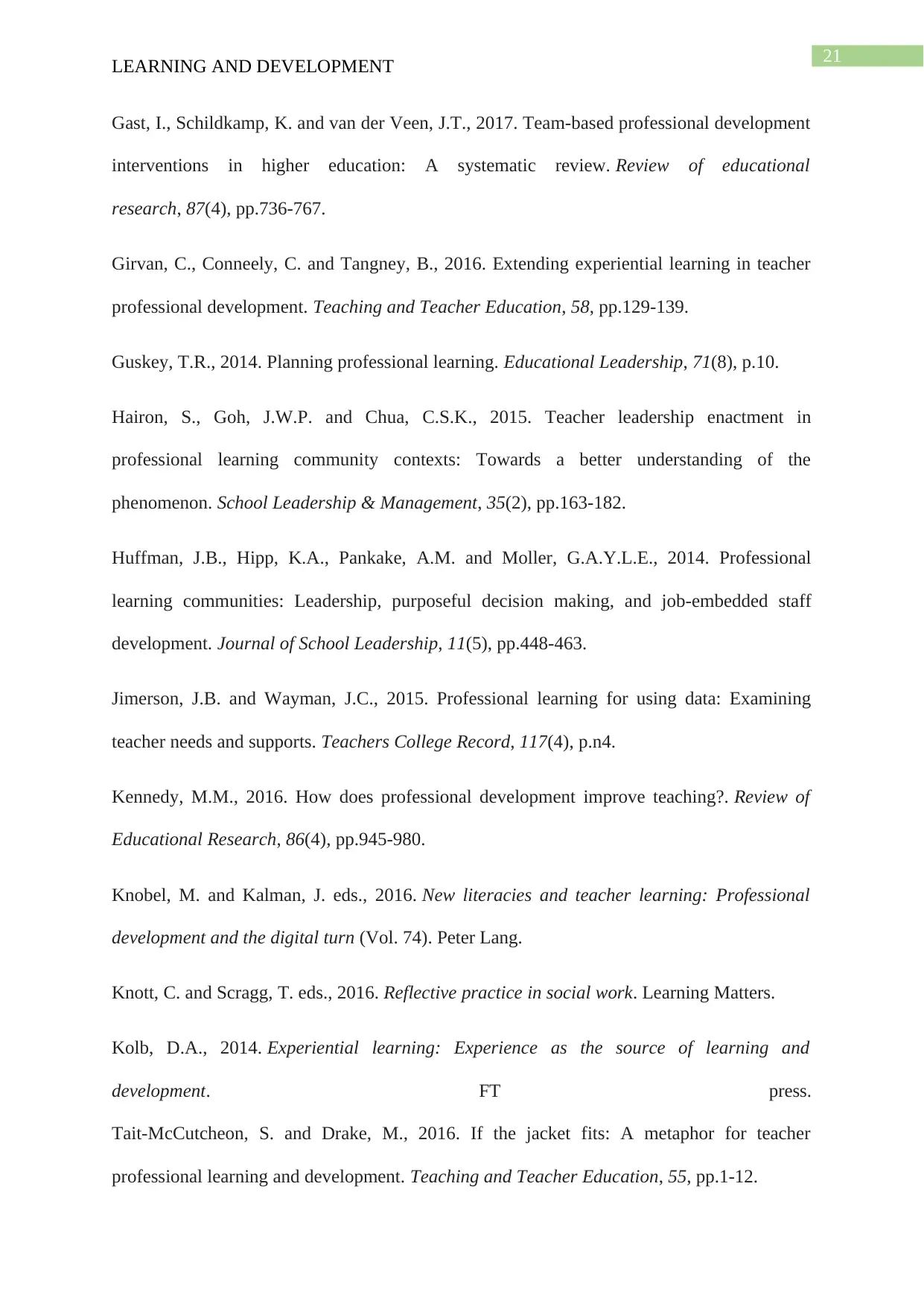
21
LEARNING AND DEVELOPMENT
Gast, I., Schildkamp, K. and van der Veen, J.T., 2017. Team-based professional development
interventions in higher education: A systematic review. Review of educational
research, 87(4), pp.736-767.
Girvan, C., Conneely, C. and Tangney, B., 2016. Extending experiential learning in teacher
professional development. Teaching and Teacher Education, 58, pp.129-139.
Guskey, T.R., 2014. Planning professional learning. Educational Leadership, 71(8), p.10.
Hairon, S., Goh, J.W.P. and Chua, C.S.K., 2015. Teacher leadership enactment in
professional learning community contexts: Towards a better understanding of the
phenomenon. School Leadership & Management, 35(2), pp.163-182.
Huffman, J.B., Hipp, K.A., Pankake, A.M. and Moller, G.A.Y.L.E., 2014. Professional
learning communities: Leadership, purposeful decision making, and job-embedded staff
development. Journal of School Leadership, 11(5), pp.448-463.
Jimerson, J.B. and Wayman, J.C., 2015. Professional learning for using data: Examining
teacher needs and supports. Teachers College Record, 117(4), p.n4.
Kennedy, M.M., 2016. How does professional development improve teaching?. Review of
Educational Research, 86(4), pp.945-980.
Knobel, M. and Kalman, J. eds., 2016. New literacies and teacher learning: Professional
development and the digital turn (Vol. 74). Peter Lang.
Knott, C. and Scragg, T. eds., 2016. Reflective practice in social work. Learning Matters.
Kolb, D.A., 2014. Experiential learning: Experience as the source of learning and
development. FT press.
Tait-McCutcheon, S. and Drake, M., 2016. If the jacket fits: A metaphor for teacher
professional learning and development. Teaching and Teacher Education, 55, pp.1-12.
LEARNING AND DEVELOPMENT
Gast, I., Schildkamp, K. and van der Veen, J.T., 2017. Team-based professional development
interventions in higher education: A systematic review. Review of educational
research, 87(4), pp.736-767.
Girvan, C., Conneely, C. and Tangney, B., 2016. Extending experiential learning in teacher
professional development. Teaching and Teacher Education, 58, pp.129-139.
Guskey, T.R., 2014. Planning professional learning. Educational Leadership, 71(8), p.10.
Hairon, S., Goh, J.W.P. and Chua, C.S.K., 2015. Teacher leadership enactment in
professional learning community contexts: Towards a better understanding of the
phenomenon. School Leadership & Management, 35(2), pp.163-182.
Huffman, J.B., Hipp, K.A., Pankake, A.M. and Moller, G.A.Y.L.E., 2014. Professional
learning communities: Leadership, purposeful decision making, and job-embedded staff
development. Journal of School Leadership, 11(5), pp.448-463.
Jimerson, J.B. and Wayman, J.C., 2015. Professional learning for using data: Examining
teacher needs and supports. Teachers College Record, 117(4), p.n4.
Kennedy, M.M., 2016. How does professional development improve teaching?. Review of
Educational Research, 86(4), pp.945-980.
Knobel, M. and Kalman, J. eds., 2016. New literacies and teacher learning: Professional
development and the digital turn (Vol. 74). Peter Lang.
Knott, C. and Scragg, T. eds., 2016. Reflective practice in social work. Learning Matters.
Kolb, D.A., 2014. Experiential learning: Experience as the source of learning and
development. FT press.
Tait-McCutcheon, S. and Drake, M., 2016. If the jacket fits: A metaphor for teacher
professional learning and development. Teaching and Teacher Education, 55, pp.1-12.
Secure Best Marks with AI Grader
Need help grading? Try our AI Grader for instant feedback on your assignments.
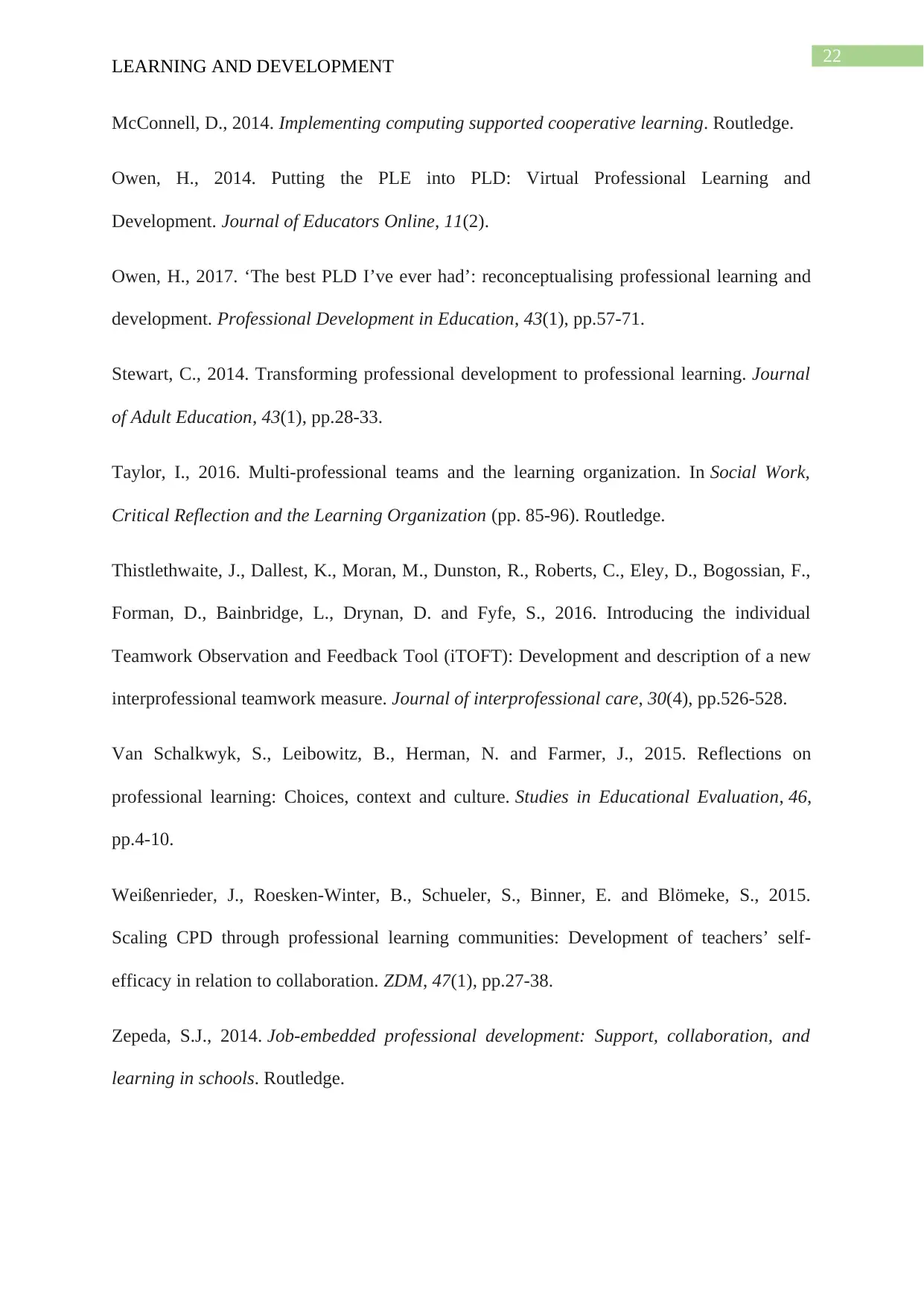
22
LEARNING AND DEVELOPMENT
McConnell, D., 2014. Implementing computing supported cooperative learning. Routledge.
Owen, H., 2014. Putting the PLE into PLD: Virtual Professional Learning and
Development. Journal of Educators Online, 11(2).
Owen, H., 2017. ‘The best PLD I’ve ever had’: reconceptualising professional learning and
development. Professional Development in Education, 43(1), pp.57-71.
Stewart, C., 2014. Transforming professional development to professional learning. Journal
of Adult Education, 43(1), pp.28-33.
Taylor, I., 2016. Multi-professional teams and the learning organization. In Social Work,
Critical Reflection and the Learning Organization (pp. 85-96). Routledge.
Thistlethwaite, J., Dallest, K., Moran, M., Dunston, R., Roberts, C., Eley, D., Bogossian, F.,
Forman, D., Bainbridge, L., Drynan, D. and Fyfe, S., 2016. Introducing the individual
Teamwork Observation and Feedback Tool (iTOFT): Development and description of a new
interprofessional teamwork measure. Journal of interprofessional care, 30(4), pp.526-528.
Van Schalkwyk, S., Leibowitz, B., Herman, N. and Farmer, J., 2015. Reflections on
professional learning: Choices, context and culture. Studies in Educational Evaluation, 46,
pp.4-10.
Weißenrieder, J., Roesken-Winter, B., Schueler, S., Binner, E. and Blömeke, S., 2015.
Scaling CPD through professional learning communities: Development of teachers’ self-
efficacy in relation to collaboration. ZDM, 47(1), pp.27-38.
Zepeda, S.J., 2014. Job-embedded professional development: Support, collaboration, and
learning in schools. Routledge.
LEARNING AND DEVELOPMENT
McConnell, D., 2014. Implementing computing supported cooperative learning. Routledge.
Owen, H., 2014. Putting the PLE into PLD: Virtual Professional Learning and
Development. Journal of Educators Online, 11(2).
Owen, H., 2017. ‘The best PLD I’ve ever had’: reconceptualising professional learning and
development. Professional Development in Education, 43(1), pp.57-71.
Stewart, C., 2014. Transforming professional development to professional learning. Journal
of Adult Education, 43(1), pp.28-33.
Taylor, I., 2016. Multi-professional teams and the learning organization. In Social Work,
Critical Reflection and the Learning Organization (pp. 85-96). Routledge.
Thistlethwaite, J., Dallest, K., Moran, M., Dunston, R., Roberts, C., Eley, D., Bogossian, F.,
Forman, D., Bainbridge, L., Drynan, D. and Fyfe, S., 2016. Introducing the individual
Teamwork Observation and Feedback Tool (iTOFT): Development and description of a new
interprofessional teamwork measure. Journal of interprofessional care, 30(4), pp.526-528.
Van Schalkwyk, S., Leibowitz, B., Herman, N. and Farmer, J., 2015. Reflections on
professional learning: Choices, context and culture. Studies in Educational Evaluation, 46,
pp.4-10.
Weißenrieder, J., Roesken-Winter, B., Schueler, S., Binner, E. and Blömeke, S., 2015.
Scaling CPD through professional learning communities: Development of teachers’ self-
efficacy in relation to collaboration. ZDM, 47(1), pp.27-38.
Zepeda, S.J., 2014. Job-embedded professional development: Support, collaboration, and
learning in schools. Routledge.
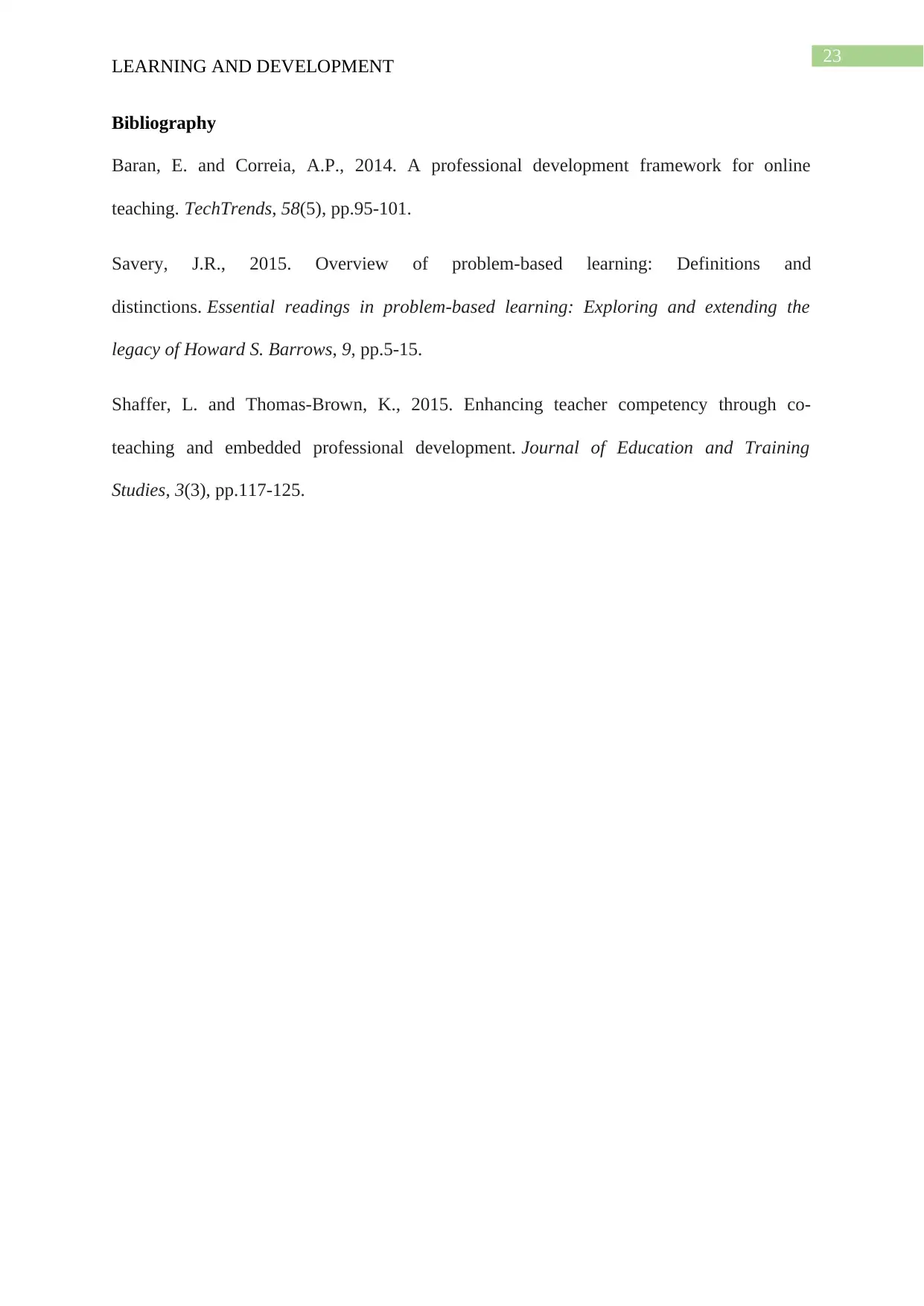
23
LEARNING AND DEVELOPMENT
Bibliography
Baran, E. and Correia, A.P., 2014. A professional development framework for online
teaching. TechTrends, 58(5), pp.95-101.
Savery, J.R., 2015. Overview of problem-based learning: Definitions and
distinctions. Essential readings in problem-based learning: Exploring and extending the
legacy of Howard S. Barrows, 9, pp.5-15.
Shaffer, L. and Thomas-Brown, K., 2015. Enhancing teacher competency through co-
teaching and embedded professional development. Journal of Education and Training
Studies, 3(3), pp.117-125.
LEARNING AND DEVELOPMENT
Bibliography
Baran, E. and Correia, A.P., 2014. A professional development framework for online
teaching. TechTrends, 58(5), pp.95-101.
Savery, J.R., 2015. Overview of problem-based learning: Definitions and
distinctions. Essential readings in problem-based learning: Exploring and extending the
legacy of Howard S. Barrows, 9, pp.5-15.
Shaffer, L. and Thomas-Brown, K., 2015. Enhancing teacher competency through co-
teaching and embedded professional development. Journal of Education and Training
Studies, 3(3), pp.117-125.
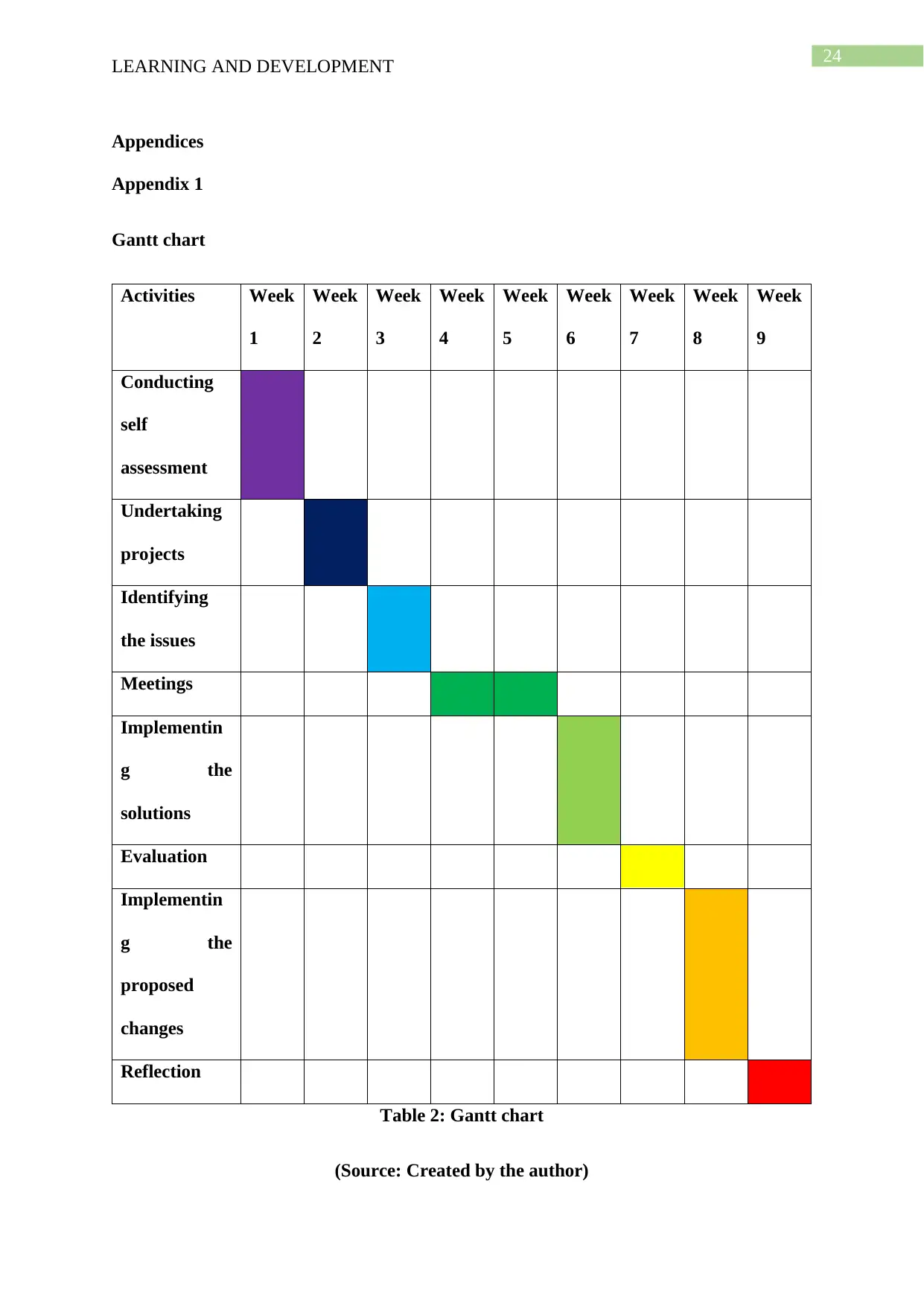
24
LEARNING AND DEVELOPMENT
Appendices
Appendix 1
Gantt chart
Activities Week
1
Week
2
Week
3
Week
4
Week
5
Week
6
Week
7
Week
8
Week
9
Conducting
self
assessment
Undertaking
projects
Identifying
the issues
Meetings
Implementin
g the
solutions
Evaluation
Implementin
g the
proposed
changes
Reflection
Table 2: Gantt chart
(Source: Created by the author)
LEARNING AND DEVELOPMENT
Appendices
Appendix 1
Gantt chart
Activities Week
1
Week
2
Week
3
Week
4
Week
5
Week
6
Week
7
Week
8
Week
9
Conducting
self
assessment
Undertaking
projects
Identifying
the issues
Meetings
Implementin
g the
solutions
Evaluation
Implementin
g the
proposed
changes
Reflection
Table 2: Gantt chart
(Source: Created by the author)
Paraphrase This Document
Need a fresh take? Get an instant paraphrase of this document with our AI Paraphraser

25
LEARNING AND DEVELOPMENT
LEARNING AND DEVELOPMENT
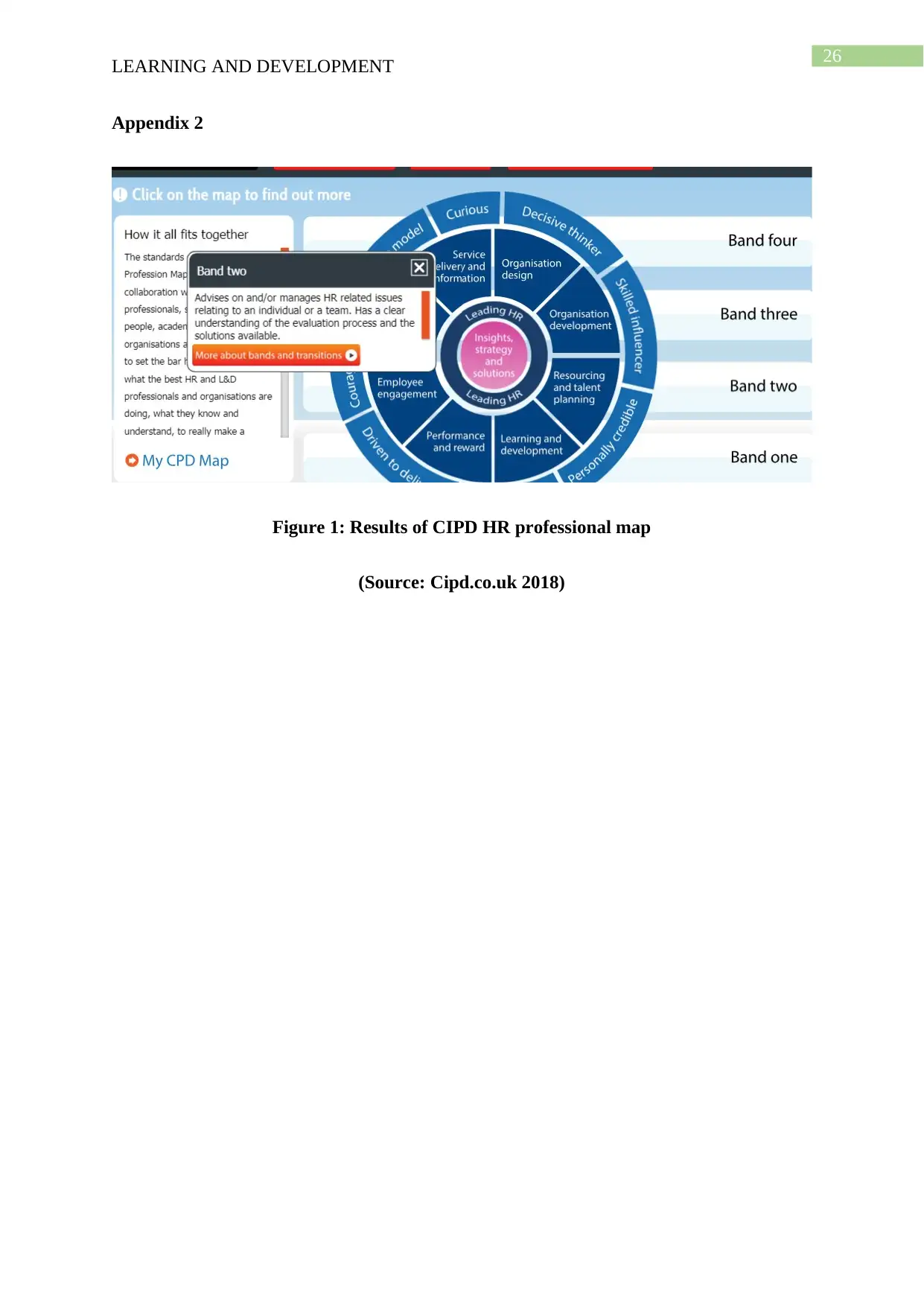
26
LEARNING AND DEVELOPMENT
Appendix 2
Figure 1: Results of CIPD HR professional map
(Source: Cipd.co.uk 2018)
LEARNING AND DEVELOPMENT
Appendix 2
Figure 1: Results of CIPD HR professional map
(Source: Cipd.co.uk 2018)
1 out of 27
Related Documents
Your All-in-One AI-Powered Toolkit for Academic Success.
+13062052269
info@desklib.com
Available 24*7 on WhatsApp / Email
![[object Object]](/_next/static/media/star-bottom.7253800d.svg)
Unlock your academic potential
© 2024 | Zucol Services PVT LTD | All rights reserved.




